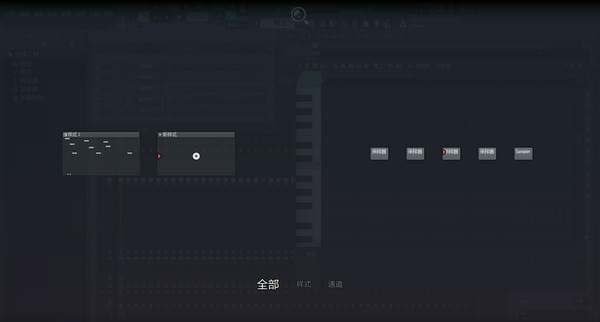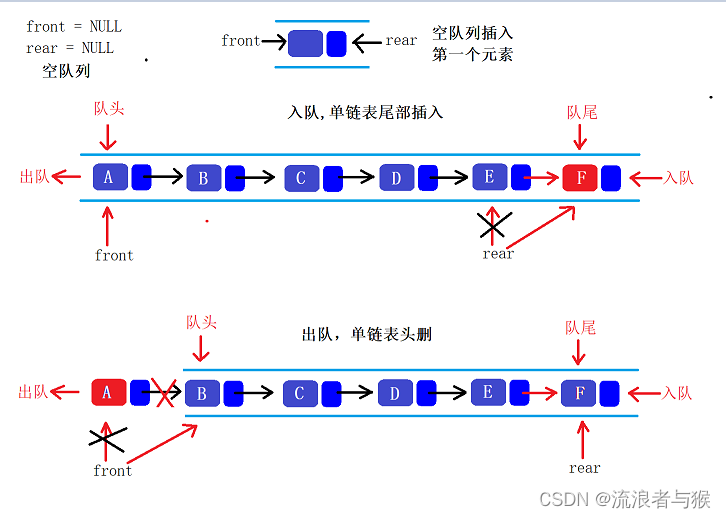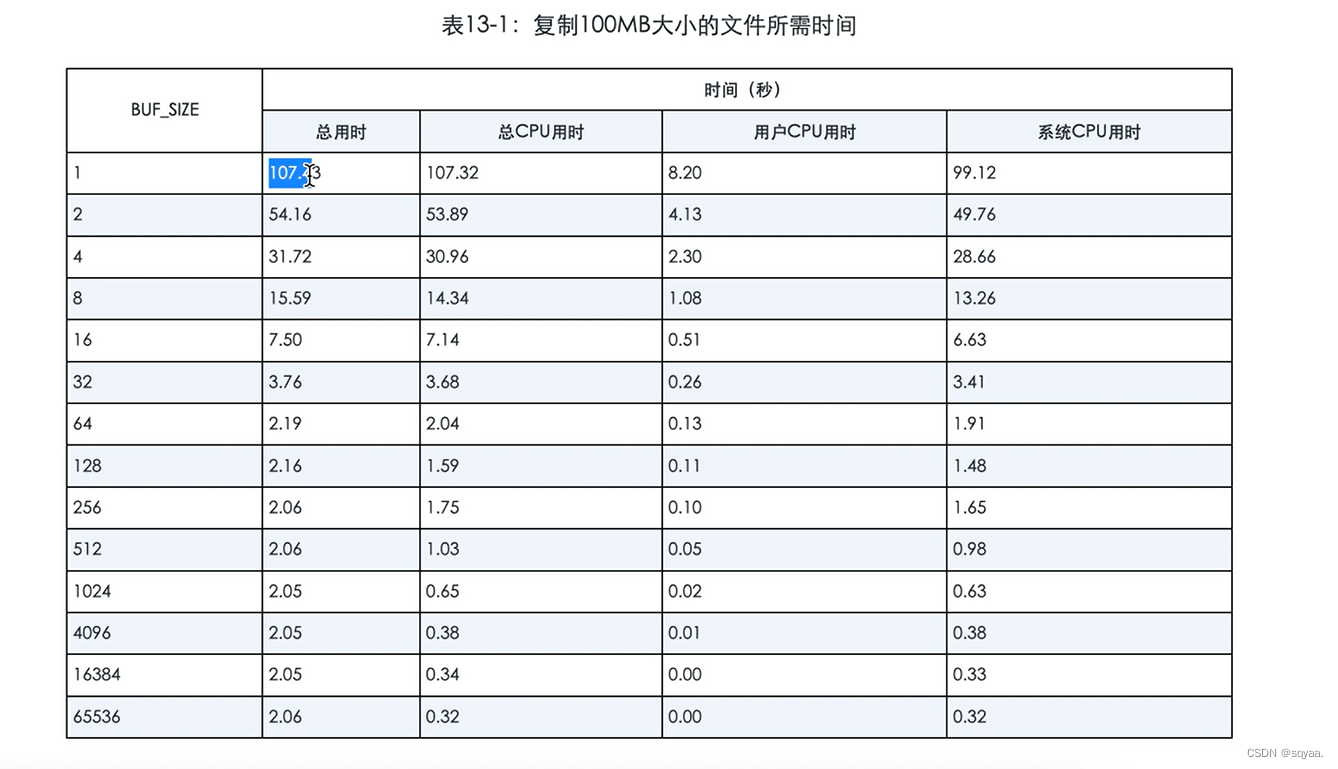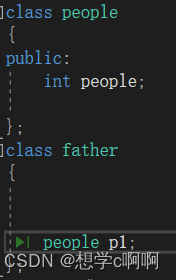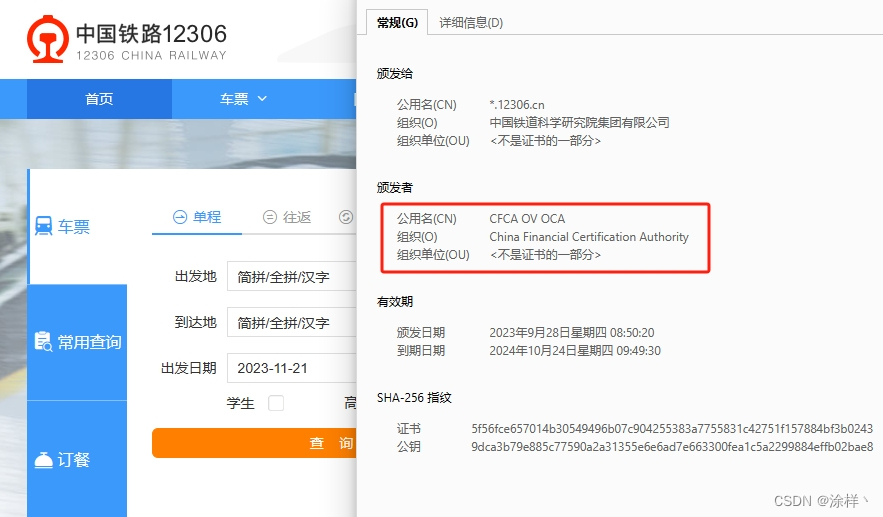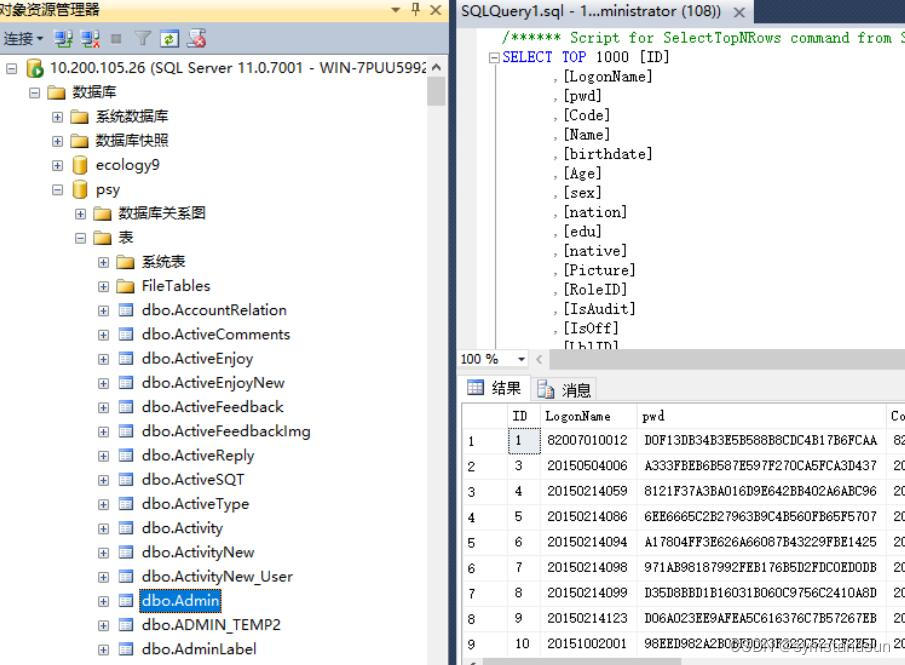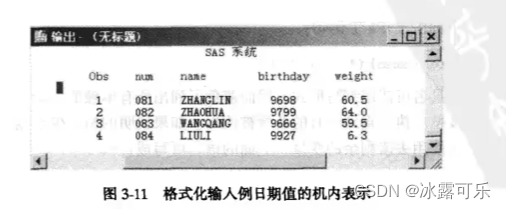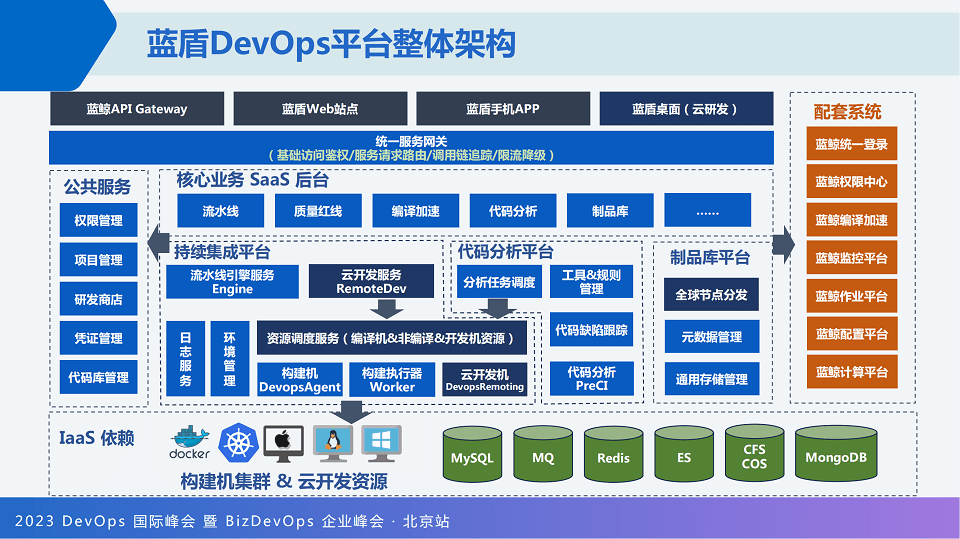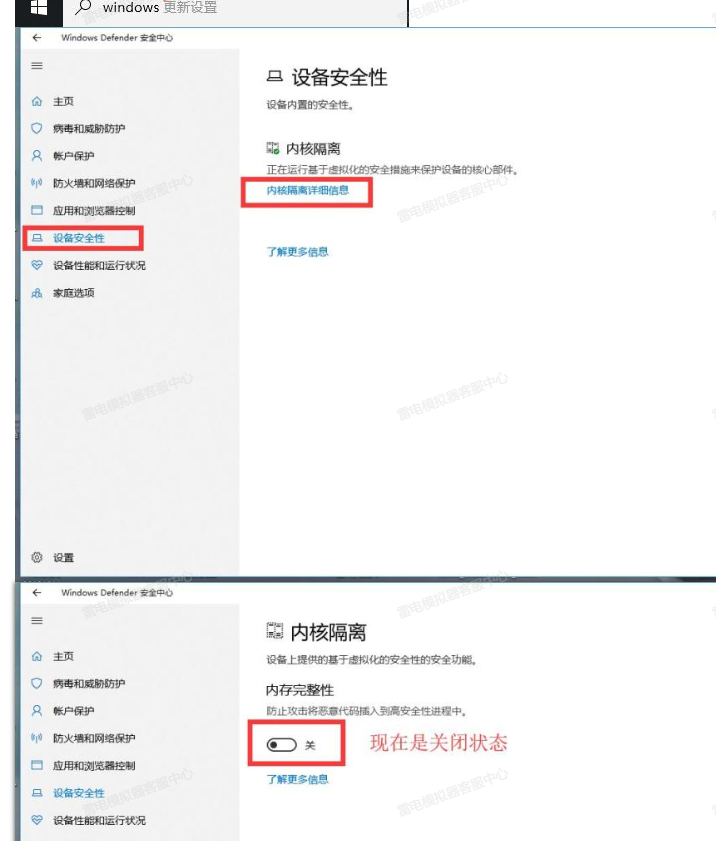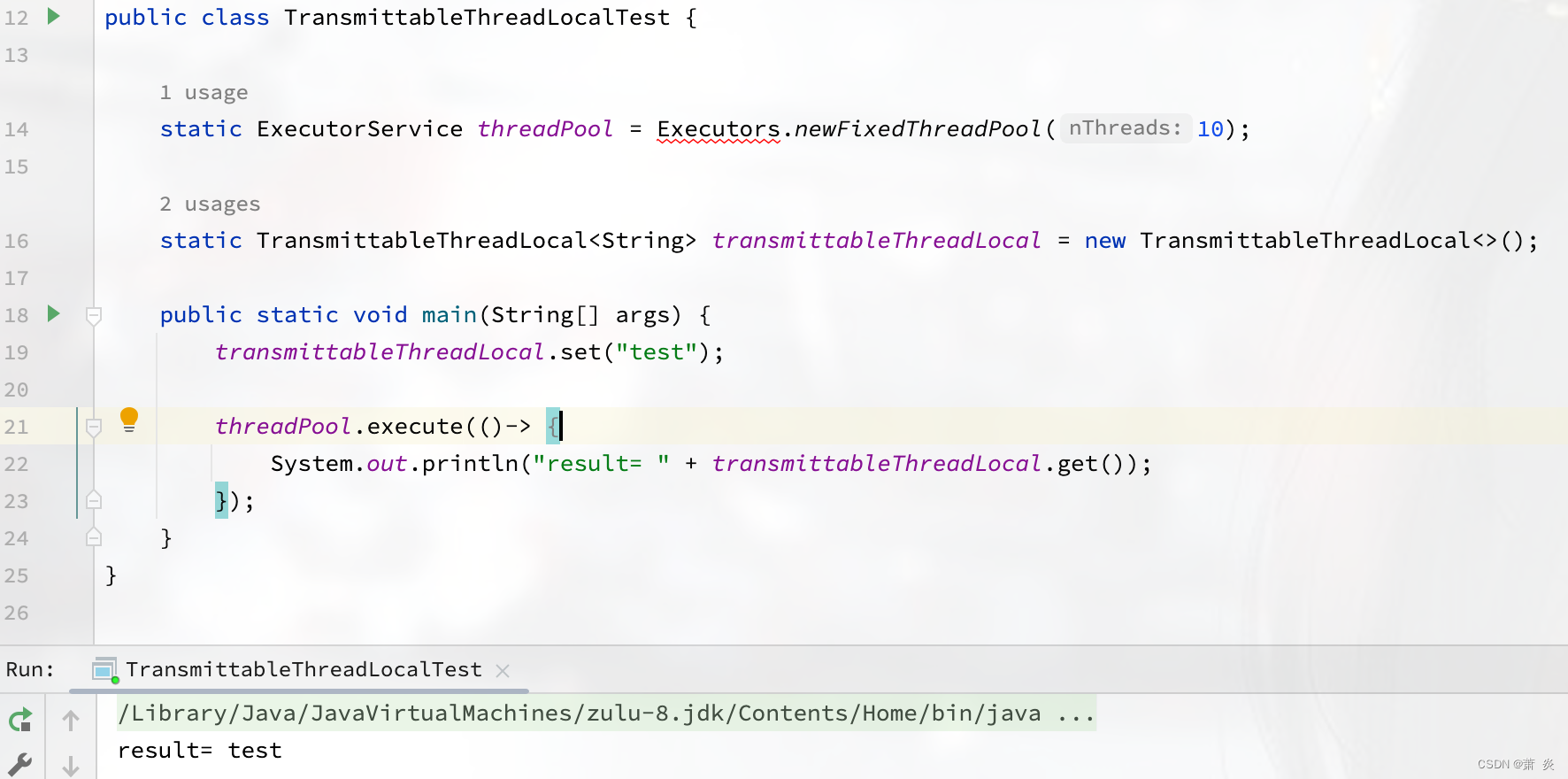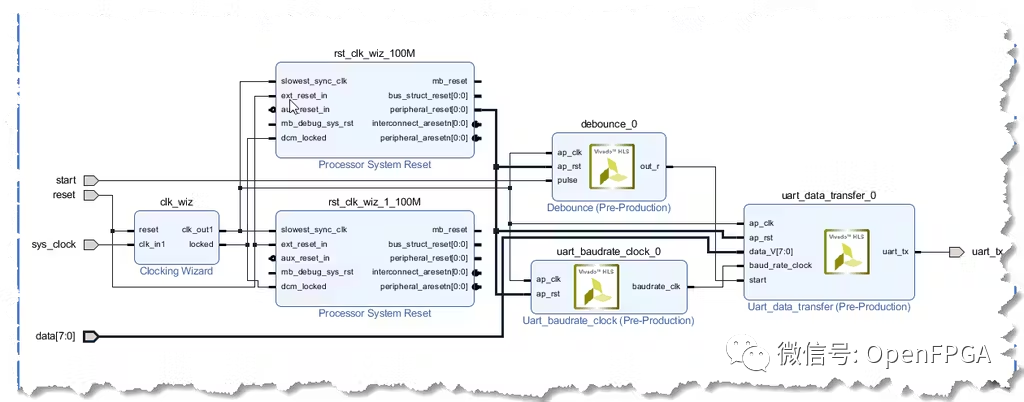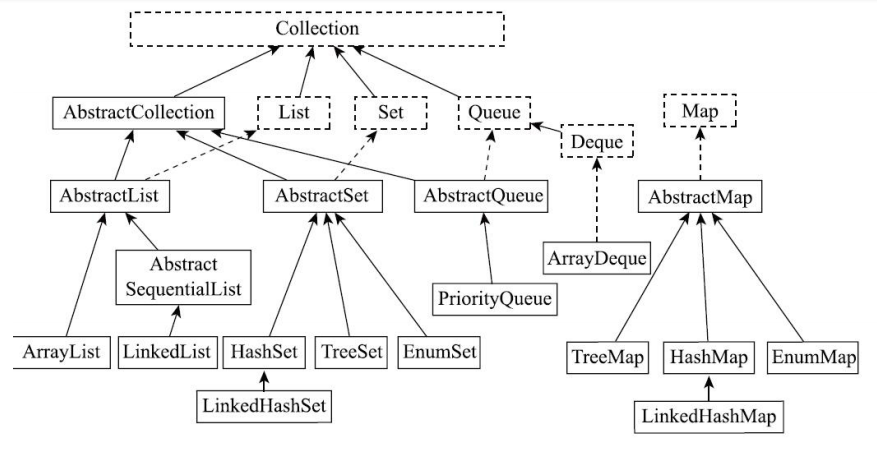文章目录
- 第 1 章:Vue 核心
- 1、 Vue 简介
- 1.官网
- 2.介绍与描述
- 3. Vue 的特点
- 4. 与其它 JS 框架的关联
- 5. Vue 周边库
- 2、初始Vue
- 3、模板语法
- 1、Vue模板语法有2大类:
- 2、插值语法和指令语法
- 4、数据绑定
- 1. 单向数据绑定
- 2. 双向数据绑定
- 5、el与data的两种写法
- 1.e1有2种写法
- 2.data有2种写法
- 3.一个重要的原则:
- 6、 MVVM 模型
- 7、数据代理
- 1、 Object.defineProperty方法:
- 2、数据代理
- 1、概念
- 2、Vue中的数据代理:
- 3、Vue中数据代理的好处:
- 4、基本原理:
- 8、事件处理
- 1、事件的基本使用:
- 2、事件修饰符
- 3、键盘事件
- 9、计算属性与监视
- 1、计算属性 computed
- 2、监视属性
- 1、监视属性 watch及简写方式:
- 1、深度监听 deep
- 3、计算属性computed和监听属性watch的对比
- 10、class 与style的绑定
- 11、条件渲染
- 1.V-if
- 2.V-show
- 3.备注:
- 12、列表渲染
- v-for指令
- 1、遍历列表时key的作用(index作为key)
- 2、遍历列表时key的作用(id作为key)
- 3、面试题: react、vue中的key有什么作用? (key的内部原理)
- 13、列表过滤
- 14、列表排序
- 15、vue检测数据的原理
- 16、收集表单数据
- 17、过滤器
- 18、内置指令与自定义指令
- 1、常用内置指令
- 19、自定义指令
- 1、自定义指令总结:
- 2、自定义指令案例(函数式及对象式)
- 20、生命周期
- 1、vm的生命周期
- 2、常用的生命周期钩子:
- 3、关于销毁Vue实例
- 常用指令总结
- 第 2 章:Vue 组件化编程
- 1、 模块与组件、模块化与组件化
- 1. 模块
- 2. 组件
- 3. 模块化
- 4. 组件化
- 2、非单文件组件
- 1、概念
- 3、Vue中使用组件的三大步骤:
- 一、 如何定义一个组件?
- 二、如何注册组件?
- 三、编写组件标签:
- 4、组件的几个注意事项
- 1.关于组件名:
- 2.关于组件标签:
- 3.一个简写方式:
- 5、组件的嵌套
- 6、关丁VueComponent:
- 7、一个重要的内置关系:
- 1.一个重要的内置关系:
- 2.为什么要有这个关系:
- 8、单文件组件
- 1. 一个.vue 文件的组成(3 个部分)
- 第 3 章:使用 Vue 脚手架
- 1 初始化脚手架
- 1、说明
- 2 、具体步骤
- 第一步(仅第一次执行):全局安装@vue/cli。
- 第二步:切换到你要创建项目的目录,然后使用命令创建项目
- 第三步:启动项目
- 备注:
- 3 模板项目的结构
- 4、关于不同版本的Vue:
- 2 ref 与 props
- 1、ref
- 2、props
- 3 混入minxin
- 4 插件
- 1、功能:
- 2、本质:
- 3、定义插件:
- 4、再main.js中使用插件:
- 5、scoped样式
- 6、组件的自定义事件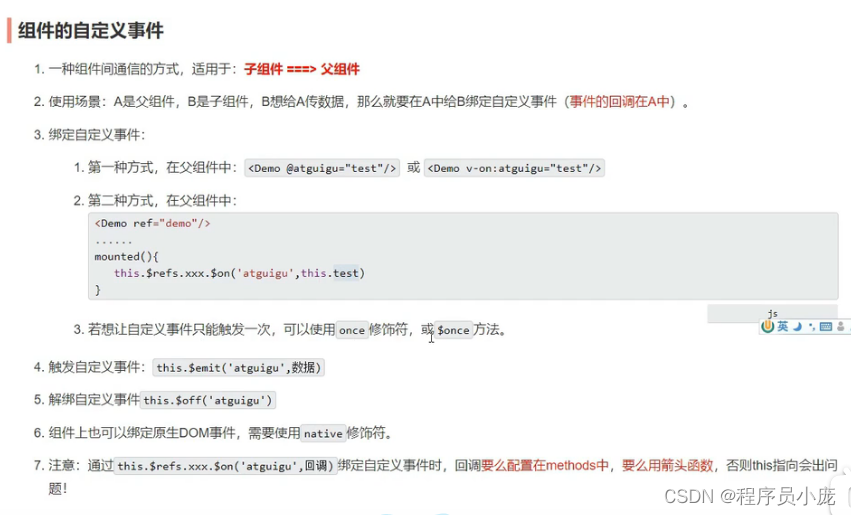
- 7、全局事件总线 (GlobalEventBus):任意组件间通信
- 8、消息订阅与发布
- 1 理解
- 2 使用 PubSubJS
- 3、总结:
- nextTick
- 9 、Vue封装的过度与动画
- 第 4 章:Vue 中的 ajax
- 1 解决开发环境 Ajax 跨域问题(代理服务器)
- 2、vue脚手架配置代理
- 3、插槽
- 1.作用:
- 2.分类:
- 3.使用方式:
- 1、默认插槽
- 2、具名插槽
- 3.作用域插槽:
- 1.理解:
- 2.具体编码
- 第 5 章:vuex
- 1、理解 vuex
- 1 vuex 是什么
- 2、什么时候使用 Vuex
- 3、搭建环境
- 1、创建文件:src/store/index.js
- 2、在mian.js中创建vm时传入store配置项
- 4、基本使用
- 1、初始化数据、配置actions、配置mutations,操作文件store.js
- 2、组件中读取vuex中的数据
- 3.组件中修改vuex中的数据:
- 5、getters的使用
- 1.概念:
- 2.在store.js 中追加getters 配置
- 3.组件中读取数据:
- 6、四个map方法的使用
- 1.mapstate方法:
- 2.mapGetters方法:
- 3.mapActions方法:
- 4.mapMutations方法:
- 7.模块化+命名空间
- 1.目的:
- 2.修改store.js
- 第 6 章:vue-router路由
- 1 vue-router 的理解
- 2 对 SPA 应用的理解
- 3 路由的理解
- 1. 什么是路由?
- 2. 路由分类
- 1. 后端路由:
- 2. 前端路由:
- 4 路由的基本使用
- 1.安装vue-router,命令:
- 2.应用插件:
- 3.编写router配置项:
- 4.实现切换(active-class可配置高亮样式)
- 5.指定展示位置
- 6.几个注意点
- 5、嵌套(多级)路由
- 1.配置路由规则,使用children配置项:
- 2.跳转 (要写完整路径) :
- 6、路由的query传参
- 1、传递参数
- 2、接收参数
- 7、命名路
- 1.作用:
- 2.如何使用
- 1.给路由命名
- 2.简化跳转:
- 8、路由的params参数
- 1、配置路由,声明接收 params参数
- 2、传递参数
- 3、接收参数
- 9.路由的props配置
- 10.```<router-link>```的replace属性
- 11.编程式路由导航
- 11、缓存路由组件
- 12.两个新的生命周期钩子
- 13、路由守卫
- 1. 作用:
- 2. 分类:
- 3. 全局守卫:
- 4. 独享守卫:
- 5. 组件内守卫:
- 14、路由器的两种工作模式
- vue3快速上手
- 一、创建Vue3.0工程
- 1.使用 vue-cli 创建
- 2.使用 vite 创建
- 3.分析工程结构
- 二、常用 Composition API
- 1.拉开序幕的setup
- 2.ref函数
- 3.reactive函数
- 4.Vue3.0中的响应式原理
- vue2.x的响应式
- Vue3.0的响应式
- 5.reactive对比ref
- 6.setup的两个注意点
- 7.计算属性与监视
- 1.computed函数
- 2.watch函数
- 3.watchEffect函数
- 8.生命周期
- 9.自定义hook函数
- 10.toRef
- 三、其它 Composition API
- 1.shallowReactive 与 shallowRef
- 2.readonly 与 shallowReadonly
- 3.toRaw 与 markRaw
- 4.customRef
- 5.provide 与 inject
- 6.响应式数据的判断
- 四、Composition API 的优势
- 1.Options API 存在的问题
- .Composition API 的优势
- 五、新的组件
- 1.Fragment
- 2.Teleport
- 3.Suspense
- 六、其他
- 1.全局API的转移
- 2.其他改变
- 第三方库
- 浏览器本地存储
第 1 章:Vue 核心
1、 Vue 简介
1.官网
- 英文官网: https://vuejs.org/
- 中文官网: https://cn.vuejs.org/
2.介绍与描述
1、动态构建用户界面的渐进式 JavaScript 框架
构造用户界面:将数据展示到用户可以看见的界面
渐进式:vue可以自底向上逐层的应用
简单应用:只需一个轻量小巧的核心库
复杂应用:可以引入各式各样的vue插件
2、 作者: 尤雨溪
3. Vue 的特点
- 遵循 MVVM 模式
- 编码简洁, 体积小, 运行效率高, 适合移动/PC 端开发
- 它本身只关注 UI, 也可以引入其它第三方库开发项目
- 采用组件化模式,提高代码复用率、且让代码更好维护
- 声明式编码,让编码人员无需直接操作DOM,提高开发效率
4. 与其它 JS 框架的关联
- 借鉴 Angular 的模板和数据绑定技术
- 借鉴 React 的组件化和虚拟 DOM 技术
5. Vue 周边库
- vue-cli: vue 脚手架
- vue-resource
- axios
- vue-router: 路由
- vuex: 状态管理
- element-ui: 基于 vue 的 UI 组件库(PC 端)等
2、初始Vue
1.想让Vue工作,就必须创建一个Vue实例,且要传入一个配置对象;
2.root容器里的代码依然符合htm1规范,只不过混入了一些特殊的Vue语法;
3.root容器里的代码被称为[Vue模板]:
4.Vue实例和容器是一 一对应的;
5.真实开发中只有一个Vue实例,并且会配合着组件一起使用;
6.{{xxx}}中的xxx要写js表达式,且xxx可以自动读取到data中的所有属性;
7.一旦data中的数据发生改变,那么模板中用到该数据的地方也会自动更新:
注意区分:JS表达式和JS代码
1、表达式:一个表达式会产成一个值,可以放在任何一个需要值的地方,如:a+b 等
2、JS代码:如for循环,if语句
<!DOCTYPE html>
<html lang="en">
<head>
<meta charset="UTF-8">
<meta http-equiv="X-UA-Compatible" content="IE=edge">
<meta name="viewport" content="width=device-width, initial-scale=1.0">
<title>Document</title>
<script type="text/javascript" src="../js/vue.js"></script>
</head>
<body>
<div id="root">
<h1>插值语法</h1>
<h1>你好,我是:{{name}}</h1>
</div>
<script type="text/javascript">
//阻止vue 在启动时生成生产提示
Vue.config.productionTip=false
//创建Vue实例
new Vue({
el:'#root',//el用于指定当前vue实例为那个容器服务,值通常为css选择器字符串
data:{ //data中用来存储数据,数据供el所指定的容器去使用,值我们暂时先写成一个对象
name:'vue'
}
})
</script>
</body>
</html>
3、模板语法
1、Vue模板语法有2大类:
1.插值语法:
功能:用于解析标签体内容。(双标签中间的内容)
写法: {{xxx}},xxx是js表达式,且可以直接读取到data中的所有属性。
2.指令语法:
功能:用于解析标签(包括: 标签属性、标签体内容、绑定事件…)
举例:v-bind:href="xxx”或 简写为 :href=“xxx”,xxx同样要写js表达式,且可以直接读取到data中的所有属性。
备注:Vue中有很多的指令,且形式都是: v-???,此处我们只是拿v-bind举个例子。
2、插值语法和指令语法
<body>
<div id="root">
<h1>插值语法</h1>
<h2>Hello,{{name}}</h2>
<h1>指令语法</h1>
<!-- 原始写法 -->
<a v-bind:href="school.url">点击我去{{school.name}}</a>
<a :href="school.url"></a>
</div>
<script type="text/javascript">
//阻止vue 在启动时生成生产提示
Vue.config.productionTip=false
//创建Vue实例
new Vue({
el:'#root',//el用于指定当前vue实例为那个容器服务,值通常为css选择器字符串
data:{ //data中用来存储数据,数据供el所指定的容器去使用,值我们暂时先写成一个对象
name:'vue',
school:{
name:'学习',
url:'https:www.baidu.com'
}
}
})
</script>
</body>
4、数据绑定
1. 单向数据绑定
- 语法:v-bind:href =“xxx” 或简写为 :href
- 特点:数据只能从 data 流向页面
2. 双向数据绑定
- 语法:v-mode:value=“xxx” 或简写为 v-model=“xxx”
- 特点:数据不仅能从 data 流向页面,还能从页面流向data
备注:
1.双向绑定一般都应用在表单类元素上 (如: input、select等)
2.v-model:value 可以简写为 v-model,因为v-model默认收集的就是value值.
如:
<body>
<div id="root">
<!-- 普通写法 -->
单向数据绑定:<input type="text" v-bind:value="name">
<br>
双向数据绑定:<input type="text" v-model:value="name">
<!-- 简写 -->
单向数据绑定:<input type="text" :value="name">
<br>
双向数据绑定:<input type="text" v-model="name">
</div>
<script type="text/javascript">
//阻止vue 在启动时生成生产提示
Vue.config.productionTip=false
//创建Vue实例
new Vue({
el:'#root',//el用于指定当前vue实例为那个容器服务,值通常为css选择器字符串
data:{ //data中用来存储数据,数据供el所指定的容器去使用,值我们暂时先写成一个对象
name:'vue'
}
})
</script>
</body>
5、el与data的两种写法
1.e1有2种写法
(1).new Vue时候配置el属性。
(2).先创建Vue实例,随后再通过vm.$mount(‘#root’)指定el的值。
2.data有2种写法
(1).对象式
(2).函数式
如何选择: 目前哪种写法都可以,以后学习到组件时,data必须使用函数式,否则会报错
3.一个重要的原则:
出Vue管理的函数,一定不要写箭头函数,一旦写了箭头函数,this就不再是Vue实例了。
如:
<body>
<div id="root">
<h1>你好:{{name}}</h1>
</div>
<script type="text/javascript">
//阻止vue 在启动时生成生产提示
Vue.config.productionTip=false
//el的两种写法
const v= new Vue({
//第一种写法
// el:'#root',
data:{ //data中用来存储数据,数据供el所指定的容器去使用,值我们暂时先写成一个对象
name:'vue'
}
})
console.log(v)
v.$mount('#root')//第二种写法
// data的两种写法
new Vue({
el:'#root',//第一种写法
// data的第一种写法:对象式
data:{
name:'vue'
}
//data的第二种写法:函数式
data:function(){
console.log(this)//此处的this是vue实例对象
return{
name:'Vue'
}
}
//函数式可以简写成
data(){
console.log(this)//此处的this是vue实例对象
return{
name:'Vue'
}
}
})
</script>
</body>
6、 MVVM 模型
- M:模型(Model) :对应 data 中的数据
- V:视图(View) :模板
- VM:视图模型(ViewModel) : Vue 实例对象
观察发现:
1.data中所有的属性,最后都出现在了vm身上。
2.vm身上所有的属性 及 Vue原型上所有属性,在Vue模板中都可以直接使用。
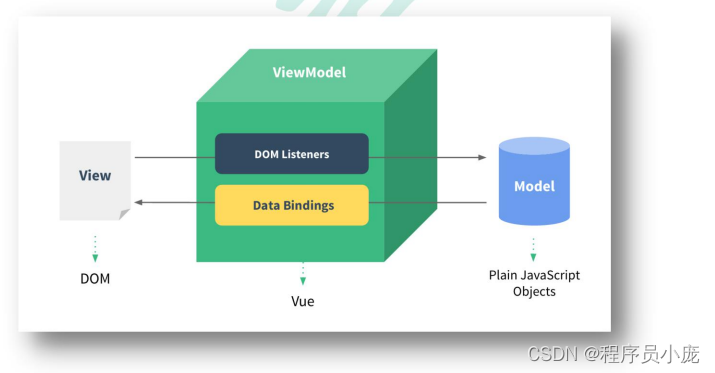
7、数据代理
1、 Object.defineProperty方法:
Object.defineProperty方法:是给一个对象添加(定义)属性用的
语法格式:
Object.defineProperty(要添加的对象,添加的属性名,{配置项(基本配置项和高级配置项)})
<body>
<script type="text/javascript">
let obj={x:100}
let obj2={y:200}
Object.defineProperty(obj2,'x',{
//基本配置项
value:18,
enumerable:true,//控制属性是否可以枚举(遍历),默认为false
writable:true,//控制属性是否可以被修改,默认值为false
configurable:true,//控制属性是否可以被删除,默认值是false
//高级配置项
//当有人读取对象的的x属性是,get函数就会被调用,且返回值就是x的值
get(){
return obj.x
},
//当有人修改对象的的x属性是,set函数就会被调用,且会收到修改的具体值
set(value){
obj.x=value
}
})
</script>
</body>
2、数据代理
1、概念
数据代理:通过一个对象代理对另一个对象中属性的操作(读/写)
2、Vue中的数据代理:
通过vm对象来代理data对象中属性的操作(读/写)
3、Vue中数据代理的好处:
更加方便的操作data中的数据
4、基本原理:
通过object.defineProperty()把data对象中所有属性添加到vm上。
为每一个添加到vm上的属性,都指定一个getter/setter。
在getter/setter内部去操作 (读/写) data中对应的属性
8、事件处理
1、事件的基本使用:
1.使用v-on:xxx 或 @xxx 绑定事件,其中xxx是事件名:
2.事件的回调需要配置在methods对象中,最终会在vm上;
3.methods中配置的函数,不要用箭头函数!否则this就不是vm了,是windows:
4.methods中配置的函数,都是被Vue所管理的函数,this的指向是vm 或 组件实例对象;
5.@click="demo”和 @click="demo($event)” 效果一致,但后者可以传参:
<!DOCTYPE html>
<html lang="en">
<head>
<meta charset="UTF-8" />
<meta http-equiv="X-UA-Compatible" content="IE=edge" />
<meta name="viewport" content="width=device-width, initial-scale=1.0" />
<title>Document</title>
<script type="text/javascript" src="../js/vue.js"></script>
</head>
<body>
<div id="root">
<h1>Hello,{{name}}</h1>
<button v-on:click="showInfo">点我提示信息</button>
<!-- 简写 -->
<button @click="showInfo1">点我提示信息(不传参数)</button>
<button @click="showInfo2(66,$event)">点我提示信息( 传参数)</button>
</div>
<script type="text/javascript">
//阻止vue 在启动时生成生产提示
Vue.config.productionTip = false;
//创建Vue实例
const vm = new Vue({
el: "#root", //el用于指定当前vue实例为那个容器服务,值通常为css选择器字符串
data: {
//data中用来存储数据,数据供el所指定的容器去使用,值我们暂时先写成一个对象
name: "vue"
},
methods:{
showInfo(event){
console.log(event.target.innerText)
alert("dddd")
},
showInfo2(number,event){
console.log(event.target.innerText)
alert("dddd",number)
}
}
});
</script>
</body>
</html>
2、事件修饰符
1.prevent: 阻止默认事件 (常用) :
2.stop:阻止事件冒泡 (常用) ;
3.once: 事件只触发一次 (常用) :
4.capture:使用事件的捕获模式;
5.self: 只有event.target是当前操作的元素时才触发事件;
6.passive:事件的默认行为立即执行,无需等待事件回调执行完毕:
注意: 修饰符可以连续写 如 @click.prevent.stop=“showInfo”
<!DOCTYPE html>
<html lang="en">
<head>
<meta charset="UTF-8" />
<meta http-equiv="X-UA-Compatible" content="IE=edge" />
<meta name="viewport" content="width=device-width, initial-scale=1.0" />
<title>Document</title>
<script type="text/javascript" src="../js/vue.js"></script>
<style>
* {
margin-top: 20px;
}
.demo1 {
height: 50px;
background-color: skyblue;
}
.box1 {
padding: 5px;
background-color: skyblue;
}
.box2 {
padding: 5px;
background-color: antiquewhite;
}
.list{
width: 200px;
height: 200px;
background-color: bisque;
overflow: auto;
}
li{
height: 100px;
}
</style>
</head>
<body>
<!--
Vue中的事件修饰符:
1.prevent: 阻止默认事件 (常用) :
2.stop:阻止事件冒泡 (常用) ;
3.once: 事件只触发一次 (常用) :
4.capture:使用事件的捕获模式;
5.self: 只有event.target是当前操作的元素时才触发事件;
6.passive:事件的默认行为立即执行,无需等待事件回调执行完毕:
-->
<div id="root">
<h1>Hello,{{name}}</h1>
<!-- 阻止默认事件(常用) -->
<a href="www.baidu.com" @click.prevent="showInfo">点我提示信息</a>
<!-- 阻止事件冒泡(常用) -->
<div class="demo1" @click="showInfo">
<button @click.stop="showInfo">点我提示信息</button>
</div>
<!-- once: 事件只触发一次 (常用) -->
<button @click.once="showInfo">点我提示信息</button>
<!-- capture:使用事件的捕获模式 -->
<div class="box1" @click.capture="showMsg()1">
div1
<div class="box2" @click="showMsg(2)">div2</div>
</div>
<!-- elf: 只有event.target是当前操作的元素时才触发事件 -->
<div class="demo1" @click.elf="showInfo">
<button @click="showInfo">点我提示信息</button>
</div>
<!-- passive:事件的默认行为立即执行,无需等待事件回调执行完毕 -->
<!-- scroll 滚动条滚动事件,wheel鼠标滚轮滚事件-->
<ul class="list" @scroll="demo">
<li>1</li>
<li>2</li>
<li>3</li>
<li>4</li>
</ul>
</div>
<script type="text/javascript">
//阻止vue 在启动时生成生产提示
Vue.config.productionTip = false;
//创建Vue实例
const vm = new Vue({
el: "#root", //el用于指定当前vue实例为那个容器服务,值通常为css选择器字符串
data: {
//data中用来存储数据,数据供el所指定的容器去使用,值我们暂时先写成一个对象
name: "vue",
},
methods: {
showInfo(event) {
console.log(event.target.innerText);
alert("dddd");
},
showMsg(msg) {
alert(msg);
},
demo(){
alert("滚动了")
}
},
});
</script>
</body>
</html>
3、键盘事件
1.Vue中常用的按键别名:
回车 => enter
删除 => delete (捕获“删除”和“退格”键)
退出 => esc
空格 => space
换行 => tab(特殊,必须配合keydown使用)
上 => up
下 => down
左 => left
右 => right
2.Vue未提供别名的按键,可以使用按键原始的key值去绑定,但注意要转为kebab-case (短横线命名)
3.系统修饰键(用法特殊) : ctr1、alt、shift、meta
(1),配合keyup使用: 按下修饰键的同时,再按下其他键,随后释放其他键,事件才被触发。
(2).配合keydown使用: 正常触发事件。
4.也可以使用keyCode去指定具体的按键(不推荐) @keyup.13=“showInfo”
5.Vue.config.keyCodes.自定义键名 = 键码,可以去定制按键别名
//自定义别名按键
Vue.config.keyCodes.huiche=13
<!DOCTYPE html>
<html lang="en">
<head>
<meta charset="UTF-8" />
<meta http-equiv="X-UA-Compatible" content="IE=edge" />
<meta name="viewport" content="width=device-width, initial-scale=1.0" />
<title>Document</title>
<script type="text/javascript" src="../js/vue.js"></script>
</head>
<body>
<div id="root">
<h1>Hello,{{name}}</h1>
<!--
keyup鼠标按下抬起时触发
keydown鼠标按下时触发
-->
<input type="text" placeholder="按下回车提示输入" @keyup.enter="showInfo"/>
</div>
<script type="text/javascript">
//阻止vue 在启动时生成生产提示
Vue.config.productionTip = false;
//自定义别名按键
Vue.config.keyCodes.huiche=13
//创建Vue实例
const vm = new Vue({
el: "#root", //el用于指定当前vue实例为那个容器服务,值通常为css选择器字符串
data: {
//data中用来存储数据,数据供el所指定的容器去使用,值我们暂时先写成一个对象
name: "vue",
},
methods: {
showInfo(e) {
// if(e.keyCode!==13) return
console.log(e.target.value);
}
},
});
</script>
</body>
</html>
9、计算属性与监视
1、计算属性 computed
1.定义:要用的属性不存在,要通过已有属性计算得来。
在 computed 对象中定义计算属性。 在页面中使用{{方法名}}来显示计算的结果。
2.原理: 底层借助了objcet,defineproperty方法提供的getter和setter。
3.get函数什么时候执行?
(1).初次读取时会执行一次。
(2).当依赖的数据发生改变时会被再次调用。
4.优势:与methods实现相比,内部有缓存机制(复用) ,效率更高,调试方便。
5.备注:
1.计算属性最终会出现在vm上,直接读取使用即可。
2.如果计算属性要被修改,那必须写set函数去响应修改,且set中要引起计算时依赖的数据发生改变
<!DOCTYPE html>
<html lang="en">
<head>
<meta charset="UTF-8" />
<meta http-equiv="X-UA-Compatible" content="IE=edge" />
<meta name="viewport" content="width=device-width, initial-scale=1.0" />
<title>Document</title>
<script type="text/javascript" src="../js/vue.js"></script>
</head>
<body>
<div id="root">
姓:<input type="text" v-model="firstName"/><br>
名:<input type="text" v-model="lastName"/><br>
全名:<span>{{fullName}}</span>
</div>
<script type="text/javascript">
//阻止vue 在启动时生成生产提示
Vue.config.productionTip = false;
//自定义别名按键
Vue.config.keyCodes.huiche=13
//创建Vue实例
const vm = new Vue({
el: "#root", //el用于指定当前vue实例为那个容器服务,值通常为css选择器字符串
data: {
//data中用来存储数据,数据供el所指定的容器去使用,值我们暂时先写成一个对象
firstName: "vue",
lastName:'三'
},
computed:{
// 完整写法
fullName:{
//get的作用:当有人读取fullName时,get就会被调用,且返回值就作为fullName的值
//get什么时候调用?1、初次读取fullName时。2、所依赖的数据发生变化时
get(){
return this.firstName+'-'+this.lastName
},
//set什么时候调用?当fullName被修改时
set(value){
const arr =value.split('-')
this.firstName=arr[0]
this.lastName=arr[1]
}
}
//简写 只考虑读取,不考虑修改时才能用
fullName(){
return this.firstName+'-'+this.lastName
}
}
})
</script>
</body>
</html>
2、监视属性
- 通过 vm 对象的$watch()或 watch 配置来监视指定的属性
- 当属性变化时, 回调函数自动调用, 在函数内部进行计算
1、监视属性 watch及简写方式:
1.当被监视的属性变化时,回调函数自动调用,进行相关操作
2.监视的属性必须存在,才能进行监视
3.监视的两种写法:
(1).new Vue时传入watch配置;当创建实例时很明确监视谁时用
(2).通过vm.$watch监视;当创建实例时很不明确监视谁时用
<!DOCTYPE html>
<html lang="en">
<head>
<meta charset="UTF-8" />
<meta http-equiv="X-UA-Compatible" content="IE=edge" />
<meta name="viewport" content="width=device-width, initial-scale=1.0" />
<title>Document</title>
<script type="text/javascript" src="../js/vue.js"></script>
</head>
<body>
<div id="root">
<h2>今天天气很{{info}}</h2>
<!-- 绑定事件的时候 @xxx='yyy' yyy可以写一些简单的语句 -->
<button @click="isHot=!isHot">切换天气1</button>
<button @click="changWeather">切换天气</button>
</div>
<script type="text/javascript">
//阻止vue 在启动时生成生产提示
Vue.config.productionTip = false;
//自定义别名按键
Vue.config.keyCodes.huiche=13
//创建Vue实例
const vm = new Vue({
el: "#root", //el用于指定当前vue实例为那个容器服务,值通常为css选择器字符串
data: {
isHot:true
},
methods: {
changWeather(){
this.isHot=!this.isHot
}
},
computed:{
info(){
return this.isHot?'炎热':'凉爽'
}
},
//当创建实例时很明确监视谁时用
//正常写法
isHot:{
//immediate:false,//初始化时让handler调用一下
//deep:true,//深度监视
//handler什么时候调用?当isHot发生改变时
handler(newValue,oldValue){
console.log("isHot被修改了",newValue,oldValue)
},
},
//简写形式 前提是没有其他配置项,只有hander是才能用
isHot(newValue,oldValue){
console.log("isHot被修改了",newValue,oldValue)
},
});
//正常写法
//当创建实例时很不明确监视谁时用
vm.$watch('isHot',{
immediate:false,//初始化时让handler调用一下
//handler什么时候调用?当isHot发生改变时
handler(newValue,oldValue){
console.log("isHot被修改了",newValue,oldValue)
}
})
//简写
vm.$watch('isHot',function(newValue,oldValue){
console.log("isHot被修改了",newValue,oldValue)
})
</script>
</body>
</html>
1、深度监听 deep
(1).Vue中的watch默认不监测对象内部值的改变 (一层)
(2).配置deep:true可以监测对象内部值改变(多层)。
备注:
(1).Vue自身可以监测对象内部值的改变,但vue提供的watch默认不可以!
(2).使用watch时根据数据的具体结构,决定是否采用深度监视。
<!DOCTYPE html>
<html lang="en">
<head>
<meta charset="UTF-8" />
<meta http-equiv="X-UA-Compatible" content="IE=edge" />
<meta name="viewport" content="width=device-width, initial-scale=1.0" />
<title>Document</title>
<script type="text/javascript" src="../js/vue.js"></script>
</head>
<body>
<div id="root">
<h2>今天天气很{{info}}</h2>
<!-- 绑定事件的时候 @xxx='yyy' yyy可以写一些简单的语句 -->
<button @click="isHot=!isHot">切换天气1</button>
<button @click="changWeather">切换天气</button>
<hr/>
<h3>a的值是:{{numbers.a}}</h3>
<button @click="numbers.a++">点我让a+1</button>
<hr/>
<h3>b的值是:{{numbers.b}}</h3>
<button @click="numbers.b++">点我让b+1</button>
</div>
<script type="text/javascript">
//阻止vue 在启动时生成生产提示
Vue.config.productionTip = false;
//自定义别名按键
Vue.config.keyCodes.huiche=13
//创建Vue实例
const vm = new Vue({
el: "#root", //el用于指定当前vue实例为那个容器服务,值通常为css选择器字符串
data: {
isHot:true,
numbers:{
a:1,
b:1
}
},
methods: {
changWeather(){
this.isHot=!this.isHot
}
},
computed:{
info(){
return this.isHot?'炎热':'凉爽'
}
},
//当创建实例时很明确监视谁时用
watch:{
isHot:{
//immediate:false,//初始化时让handler调用一下
//handler什么时候调用?当isHot发生改变时
handler(newValue,oldValue){
console.log("isHot被修改了",newValue,oldValue)
},
},
//监视多级结构中某个属性的变化
'number.a':{
handler(){
console.log("a被改变了")
},
},
//监视多级结构中所有属性的变化
numbers:{
deep:true,
handler(){
console.log("a被改变了")
},
}
}
});
</script>
</body>
</html>
3、计算属性computed和监听属性watch的对比
computed利lwatch之间的区别:
1.computed能完成的功能,watch都可以完成。
2.watch能完成的功能,computed不一定能完成,例如: watch可以进行异步操作。
两个重要的小原则:
1.所被Vue管理的函数,最好写成普通函数,这样this的指向才是vm 或 组件实例对象。
2.所有不被Vue所管理的函数(定时器的回调函数、ajax的回调函数等),最好写成箭头函数,这样this的指向才是vm 或 组件实例对象。
10、class 与style的绑定
1。class样式
写法:class="xxxxx可以是宁符串、对象、数组。
字符串写法适用于:类名不确定,要动态获取。
对象写法适用于:要绑定多个样式,个数不确定,名字也不确定。
数组写法适用于:要绑定多个样式,个数确定,名宁也确定,但不确定用不用,
2。style样式
:style="(fontsize: xxx]“其中xxx是动态值。
:style=”[a,b]"其中a、b是样式对象。
<!DOCTYPE html>
<html lang="en">
<head>
<meta charset="UTF-8" />
<meta http-equiv="X-UA-Compatible" content="IE=edge" />
<meta name="viewport" content="width=device-width, initial-scale=1.0" />
<title>Document</title>
<script type="text/javascript" src="../js/vue.js"></script>
<style>
.basic{
}
.happy{
}
.sad{
}
</style>
</head>
<body>
<div id="root">
<!-- 绑定class样式--字符串写法,适用于:样式的类名不确定,需要动态指定 -->
<div class="basic" :class="mood" @click="chanageMood">{{name}}</div>
<!-- 绑定class样式--数组写法,适用于:要绑定的样式个数不确定、名字也不确定 -->
<div class="basic" :class="classArr">{{name}}</div>I
<!-- 绑定class样式--对象写法,适用于:要绑定的样式个数确定、名字也确定,但要动态决定用不用 -->
<div class="basic" :class="calssObj">{{name}}</div>I
<!-- 绑定style样式--对象写法 -->
<div class="basic" :style="styleObj">{{name}}</div>I
</div>
<script type="text/javascript">
//阻止vue 在启动时生成生产提示
Vue.config.productionTip = false;
//创建Vue实例
const vm = new Vue({
el: "#root", //el用于指定当前vue实例为那个容器服务,值通常为css选择器字符串
data: {
name:'Vue',
mood:'normal',
classArr:['style1','style2','style3'],
classObj:{
class1:false,
class2:false
},
styleObj:{
fontSize:'40px',
color:'red',
backgroundColor:'orange'
}
},
methods: {
chanageMood(){
this.mood='变换后的class名'
}
},
});
</script>
</body>
</html>
11、条件渲染
1.V-if
写法:
(1).v-if=“表达式”
(2).V-else-if=“表达式”
(3).v-else=“表达式”
适用于:切换频率较低的场景。
特点:不展示的DOM元素直接被移除。
注意:v-if可以和:v-else-if、v-else一起使用,但要求结构不能被“打断”
2.V-show
写法:v-show="表达式"适用于:切换频率较高的场景。
特点:不展示的DOM元素术被移除,仅仅是使用样式隐藏掉
3.备注:
使用v-if的时,元素可能无法获取到,而使用v-show一定可以获取到。
<!DOCTYPE html>
<html lang="en">
<head>
<meta charset="UTF-8" />
<meta http-equiv="X-UA-Compatible" content="IE=edge" />
<meta name="viewport" content="width=device-width, initial-scale=1.0" />
<title>Document</title>
<script type="text/javascript" src="../js/vue.js"></script>
<style>
</style>
</head>
<body>
<div id="root">
<!-- 使用v-show做条件渲染 -->
<h2 v-show="false">欢迎来到{{name}}</h2>
<!-- 使用v-if做条件渲染 -->
<h2 v-if="false">欢迎来到{{name}}</h2>
<!-- v-else利v-else-if -->
<div v-if="n === 1">Angular</div>
<div>@</div>//等于打断了
<div v-else-if="n === 2">React</div>
<div v-else-if="n === 3">Vue</div>
<div v-else>哈哈</div>
<!-- template模板,不影响代码结构 v-if与template的配合使用 -->
<template v-if="n===1">
<h2>dddd</h2>
<h2>dddd</h2>
<h2>dddd</h2>
</template>
</div>
<script type="text/javascript">
//阻止vue 在启动时生成生产提示
Vue.config.productionTip = false;
//创建Vue实例
const vm = new Vue({
el: "#root", //el用于指定当前vue实例为那个容器服务,值通常为css选择器字符串
data: {
name:'Vue',
}
});
</script>
</body>
</html>
12、列表渲染
v-for指令
1.用于展示列表数据
2.语法: v-for="(item,index) in xxx”:key=“index” 或 v-for="item in xxx”:key=“item.id”
3.可遍历: 数组、对象、字符串(用的很少)、指定次数(用的很少)
<!DOCTYPE html>
<html lang="en">
<head>
<meta charset="UTF-8" />
<meta http-equiv="X-UA-Compatible" content="IE=edge" />
<meta name="viewport" content="width=device-width, initial-scale=1.0" />
<title>Document</title>
<script type="text/javascript" src="../js/vue.js"></script>
<style>
</style>
</head>
<body>
<div id="root">
<!-- 遍历数组 -->
<h2>人员列表(遍历数组)</h2>
<ul>
<!-- key的写法一:<li v-for="person in persons" :key="person.id"> -->
<!-- key的写法二: <li v-for="(person,index) in persons" ::key="index"> -->
<li v-for="(person,index) in persons" :key="index">
{{person.name}}-{{person.age}}
</li>
</ul>
<!-- 遍历对象 -->
<h2>汽车信息(遍历对象)</h2>
<ul>
<li v-for="(value,k) in car" :key="k">
{{k}}----{{value}}
</li>
</ul>
<!-- 遍历字符串 -->
<h2>测试遍历字符串(用的少)</h2>
<ul>
<li v-for="(value,k) in str" :key="k">
{{k}}----{{value}}
</li>
</ul>
<!-- 遍历指定次数 -->
<h2>测试遍历指定次数(用的少)</h2>
<ul>
<li v-for="(value,k) in 5" :key="k">
{{k}}----{{value}}
</li>
</ul>
</div>
<script type="text/javascript">
//阻止vue 在启动时生成生产提示
Vue.config.productionTip = false;
//创建Vue实例
const vm = new Vue({
el: "#root", //el用于指定当前vue实例为那个容器服务,值通常为css选择器字符串
data: {
persons:[
{id:'001',name:'张三1',age:'18'},
{id:'002',name:'张三2',age:'188'},
{id:'003',name:'张三3',age:'198'}
],
car:{
name:'奥迪A3',
price:'18万'
},
str:'hello world'
}
});
</script>
</body>
</html>
1、遍历列表时key的作用(index作为key)

2、遍历列表时key的作用(id作为key)
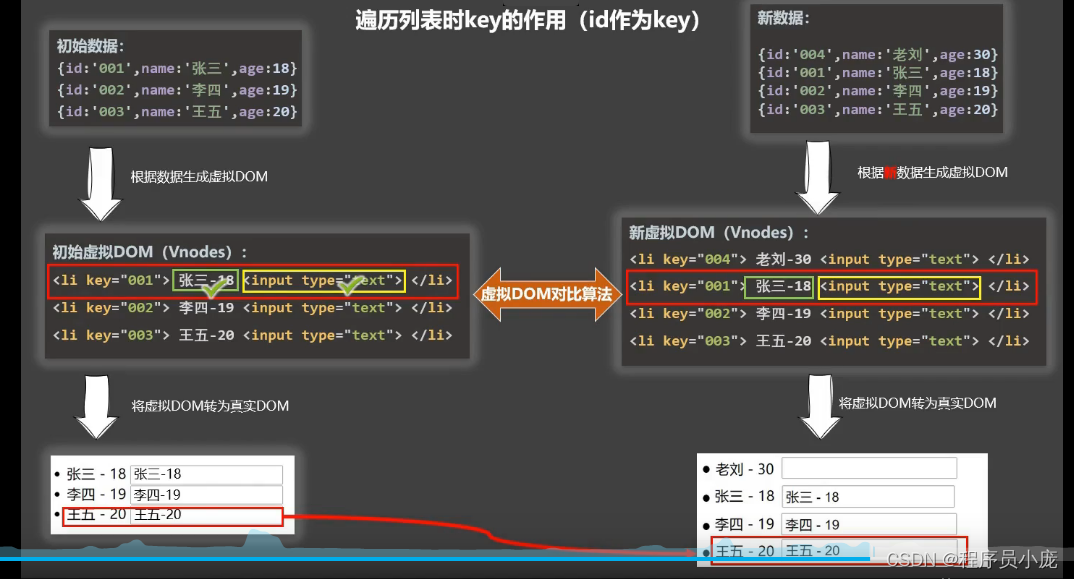
3、面试题: react、vue中的key有什么作用? (key的内部原理)
1。虚拟DOM中key的作用:
key是虚拟DOM对象的标识,当状态中的数据发生变化时,Vue会根据[新数据]生成[新的虚拟DOM]随后Vue进行[新虚拟DOM] 与[旧虚拟DOM] 的差异比较,比较规则如下:
2.对比规则:
- (1).旧虚拟DOM中找到了与新虚拟DOM相同的key:
若虚拟DOM中内容没变,直接使用之前的真实DOM!
若虚拟DOM中内容变了,则生成新的真实DOM,随后替换掉贞面中之前的真实DOM.
- (2).旧虚拟DOM中未找到与新虚拟DOM相同的key
创建新的真实DOM,随后渲染到到页面。
3。用index作为key可能会引发的问题:
- 1。若对数据进行:逆序添加、逆序删除等破坏顺序操作:会产生没有必要的真实DOM更新 ==> 界面效果没问题,但效率低。
- 2。如果结构中还包含输入类的DOM:会产生错误DOM更新 ==> 界面有问题。
4。开发中如何选择key?:
- 1.最好使用每条数据的唯一标识作为key,比如id、手机号、身份证号、学号等唯一值。
- 2.如果不存在对数据的逆序添加、逆序删除等破坏顺序操作,仅用于渲染列表用于展示,使用index作为key是没有问题的。
13、列表过滤
<!DOCTYPE html>
<html lang="en">
<head>
<meta charset="UTF-8" />
<meta http-equiv="X-UA-Compatible" content="IE=edge" />
<meta name="viewport" content="width=device-width, initial-scale=1.0" />
<title>Document</title>
<script type="text/javascript" src="../js/vue.js"></script>
<style>
</style>
</head>
<body>
<div id="root">
<!-- 遍历数组 -->
<h2>人员列表(遍历数组)</h2>
<input type="text" placeholder="请输入名字" v-model="keyworkd"/>
<ul>
<li v-for="(person,index) in filPersons" :key="index">
{{person.name}}-{{person.age}}
</li>
</ul>
</div>
<script type="text/javascript">
//阻止vue 在启动时生成生产提示
Vue.config.productionTip = false;
//watch实现
/* const vm = new Vue({
el: "#root", //el用于指定当前vue实例为那个容器服务,值通常为css选择器字符串
data: {
keyworkd:'',
filPersons:[],
persons:[
{id:'001',name:'张三1',age:'18'},
{id:'002',name:'张三2',age:'188'},
{id:'003',name:'张三3',age:'198'}
]
},
watch:{
keyworkd:{
immediate:true,
handler(val){
this.filPersons = this.persons.filter((p)=>{
return p.name.indexOf(val) !== -1
})
}
}
}
}); */
//用computed实现
const vm = new Vue({
el: "#root", //el用于指定当前vue实例为那个容器服务,值通常为css选择器字符串
data: {
keyworkd:'',
persons:[
{id:'001',name:'张三1',age:'18'},
{id:'002',name:'张三2',age:'188'},
{id:'003',name:'张三3',age:'198'}
]
},
computed:{
filPerons(){
return this.persons.filter((p)=>{
return p.name.indexOf(this.keyworkd) !== -1
})
}
}
});
</script>
</body>
</html>
14、列表排序
<!DOCTYPE html>
<html lang="en">
<head>
<meta charset="UTF-8" />
<meta http-equiv="X-UA-Compatible" content="IE=edge" />
<meta name="viewport" content="width=device-width, initial-scale=1.0" />
<title>Document</title>
<script type="text/javascript" src="../js/vue.js"></script>
<style>
</style>
</head>
<body>
<div id="root">
<!-- 遍历数组 -->
<h2>人员列表(遍历数组)</h2>
<input type="text" placeholder="请输入名字" v-model="keyworkd"/>
<button @click='sortType=2'>升序</button>
<button @click='sortType=1'>降序序</button>
<button @click='sortType=0'>原序</button>
<ul>
<li v-for="(person,index) in filPersons" :key="index">
{{person.name}}-{{person.age}}
</li>
</ul>
</div>
<script type="text/javascript">
//阻止vue 在启动时生成生产提示
Vue.config.productionTip = false;
//watch实现
/* const vm = new Vue({
el: "#root", //el用于指定当前vue实例为那个容器服务,值通常为css选择器字符串
data: {
keyworkd:'',
filPersons:[],
persons:[
{id:'001',name:'张三1',age:'18'},
{id:'002',name:'张三2',age:'188'},
{id:'003',name:'张三3',age:'198'}
]
},
watch:{
keyworkd:{
immediate:true,
handler(val){
this.filPersons = this.persons.filter((p)=>{
return p.name.indexOf(val) !== -1
})
}
}
}
}); */
//用computed实现
const vm = new Vue({
el: "#root", //el用于指定当前vue实例为那个容器服务,值通常为css选择器字符串
data: {
keyworkd:'',
sortType:0,//0代表原顺序 1 降序 2 升序
persons:[
{id:'001',name:'张三1',age:'18'},
{id:'002',name:'张三2',age:'188'},
{id:'003',name:'张三3',age:'198'}
]
},
computed:{
filPerons(){
const arr= this.persons.filter((p)=>{
return p.name.indexOf(this.keyworkd) !== -1
})
if(this.sortType){
arr.sort((p1,p2)=>{
return this.sortType===1?p2.age-p1.age:p1.age-p2.age
})
}
return arr
}
}
});
</script>
</body>
</html>
15、vue检测数据的原理
1,vue会监视data中所有层次数据。
2。如何监测对象中的数据?
通过setter实现监视,且要在new Vue时就传入要监测的数据。
(1).对象中后追加的属性,Vue默认不做响应式处理
(2).如需给后添加的属性做响应式,请使用如下API:
Vue.set(target,propertyName/index, value) 或
vm.$set(target,propertyName/index,value)
3,如何监测数组中的数据?
通过包裹数组更新元素的方法实现,本质就是做了两件事:
(1).调用原生对应的方法对数组进行更新。
(2).重新解析模板,进而更新页面。
4.在Vue修改数组中的某个元素一定要用如下方法:
1.使用这些API:push()、pop()、shift()、unshift()、splice()、sort()、reverse()
2.Vue.set() 或 vm.$set()
特别注意: Vue.set() 和 vm.$set() 不能给vm 或 vm的根数据对象 添加属性
16、收集表单数据
若:<input type="text"/>,则v-model收集的是value值,用户输入的就是value值。
若:<input type="radio"/>,则v-model收集的是value值,且要给标签配置value值
若: <input type="checkbox"/>
1.没有配置input的value属性,那么收集的就是checked (勾选 or 未勾选,是布尔值)
2.配置input的value属性:
(1)v-model的初始值是非数组,那么收集的就是checked(勾选 or 未勾选,是布尔值)
(2)v-model的初始值是数组,那么收集的的就是value组成的数组
备注:v-model的三个修饰符:
lazy:失去焦点再收集数据
number:输入字符串转为有效的数字
trim:输入首尾空格过滤
<!DOCTYPE html>
<html lang="en">
<head>
<meta charset="UTF-8" />
<meta http-equiv="X-UA-Compatible" content="IE=edge" />
<meta name="viewport" content="width=device-width, initial-scale=1.0" />
<title>Document</title>
<script type="text/javascript" src="../js/vue.js"></script>
<style>
</style>
</head>
<body>
<div id="root">
<form @submit='demo'> //绑定提交事件
账号: <input type="text" v-model.trim="account"/><br>
密码:<input type="password" v-model="password"/><br>
年龄:<input type="number" v-model.number="age"/><br>
性别:
男:<input type="radio" name="sex" value="男" checked v-model="sex"/>
女:<input type="radio" name="sex" value="女" v-model="sex"/><br>
爱好:
学习:<input type="checkbox" value="学习" v-model="hobby">
学习1:<input type="checkbox" value="学习1" v-model="hobby">
学习2:<input type="checkbox" value="学习2" v-model="hobby"><br>
所属校区:
<select v-model="city">
<option value="">请选择校区</option>
<option value="1">1</option>
<option value="2">2</option>
<option value="3">3</option>
</select>
<br>
其他:
<textarea v-model.lazy="other"></textarea><br>
<input type="checkbox" v-model="agree"> 阅读并接受<a href="www.baidu.com">用户协议</a>
<br>
<button>提交</button>
</form>
</div>
<script type="text/javascript">
//阻止vue 在启动时生成生产提示
Vue.config.productionTip = false;
const vm = new Vue({
el: "#root", //el用于指定当前vue实例为那个容器服务,值通常为css选择器字符串
data: {
account:'',
password:'',
sex:'',
age:'',
hobby:[],
city:'',
other:'',
agree:''
},
methods: {
demo(){
console.log(JSON.stringify(this._data))
}
},
});
</script>
</body>
</html>
17、过滤器
定义:对要显示的数据进行特定格式化后再显示(适用于一些简单逻辑的处理)
语法:
1.注册过滤器:Vue.filter(name,callback) 或 new Vue{filters:{}}
2.使用过滤器:{{ xxx | 过滤器名}} 或 v-bind:属性 = “xxx | 过滤器名
备注:
1.过滤器也可以接收额外参数、多个过滤器也可以串联
2.并没有改变原本的数据,是产生新的对应的数据
<!DOCTYPE html>
<html lang="en">
<head>
<meta charset="UTF-8" />
<meta http-equiv="X-UA-Compatible" content="IE=edge" />
<meta name="viewport" content="width=device-width, initial-scale=1.0" />
<title>Document</title>
<script type="text/javascript" src="../js/vue.js"></script>
<script type="text/javascript" src="../js/dayjs.min.js"></script>
<style>
</style>
</head>
<body>
<div id="root">
<h1>显示格式化后的时间</h1>
<!-- 计算属性实现 -->
现在是:<h2>{{time}}</h2>
<!-- methods实现 -->
现在是:<h2>{{getFmtTime()}}</h2>
<!-- 过滤器实现 (不传参数)-->
现在是:<h2>{{time | timeFormater}}</h2>
<!-- 过滤器实现 (传参数)-->
现在是:<h2>{{time | timeFormater('yyyy_MM_DD') |mySlice }}</h2>
</div>
<script type="text/javascript">
//阻止vue 在启动时生成生产提示
Vue.config.productionTip = false;
//全局过滤器
Vue.filter('mySlice',function(value){
return value.slice(0,4)
})
const vm = new Vue({
el: "#root", //el用于指定当前vue实例为那个容器服务,值通常为css选择器字符串
data: {
time:1621561377603
},
//计算属性实现
computed:{
fmtTime(){
return dayjs(this.time).format('yyyy-MM-DD HH:mm:ss')
}
},
//methods实现
methods: {
getFmtTime(){
return dayjs(this.time).format('yyyy-MM-DD HH:mm:ss')
}
},
//过滤器实现,(局部过滤器)
filters:{ //过滤器配置项
timeFormater(value,str='yyyy-MM-DD HH:mm:ss'){
return dayjs(value).format(str)
},
mySlice(value){
return value.slice(0,4)
}
}
});
</script>
</body>
</html>
18、内置指令与自定义指令
1、常用内置指令
v-text指令:
1.作用:向其所在的节点中渲染文本内容。(会替换内容,可以解析html标签)
2.与插值语法的区别: v-text会替换掉节点中的内容,{[xx}}则不会
v-html: 和v-text一样
v-html: 和v-text一样,但能解析html标签
1.作用:向指定节点中渲染包含htm1结构的内容。
2.与插值语法的区别:
(1).v-htm1会替换掉节点中所有的内容,{{xx}}则不会
(2).v-htm1可以识别htm1结构。
3.严重注意: v-html有安全性问题!!! !
(1).在网站上动态渲染任意HTML是非常危险的,容易导致XSS攻击。
(2).一定要在可信的内容上使用v-htm1,永不要用在用户提交的内容上!
v-cloak (没有值) :
1.本质是一个特殊属性,Vue实例创建完毕并接管容器后,会厕掉v-cloak属性。
2.使用css配合v-cloak可以解决网速慢时页面展示出{[xxx}}的问题。
v-once指令:
1.v-once所在节点在初次动态渲染后,就视为静态内容了。
2.以后数据的改变不会引起v-once所在结构的更新,可以用于优化性能。
V-pre(没有值)
1.跳过其所在节点的编译过程。
2.可利用它跳过:没有使用指令语法、没有使用插值语法的节点,会加快编译
<!DOCTYPE html>
<html lang="en">
<head>
<meta charset="UTF-8" />
<meta http-equiv="X-UA-Compatible" content="IE=edge" />
<meta name="viewport" content="width=device-width, initial-scale=1.0" />
<title>Document</title>
<script type="text/javascript" src="../js/vue.js"></script>
<script type="text/javascript" src="../js/dayjs.min.js"></script>
<style>
/* v-cloak用 */
[v-cloak]{
display: none;
}
</style>
</head>
<body>
<div id="root">
<div v-text="name"></div>
<div v-html="str"></div>
<h1 v-cloak>{{name1}}</h1>
<h2 v-once>初始的n值是:{{n}}</h2>
<h2>当前的n值是:{{n}}</h2>
<button @click="n++">点我n+1</button>
<h1 v-pre>Vue不简单</h1>
</div>
<script type="text/javascript">
//阻止vue 在启动时生成生产提示
Vue.config.productionTip = false;
const vm = new Vue({
el: "#root", //el用于指定当前vue实例为那个容器服务,值通常为css选择器字符串
data: {
name:'vue',
str:'<h1>xxxxx</h1>',
name1:'pppp',
n:1
},
});
</script>
</body>
</html>
19、自定义指令
1、自定义指令总结:
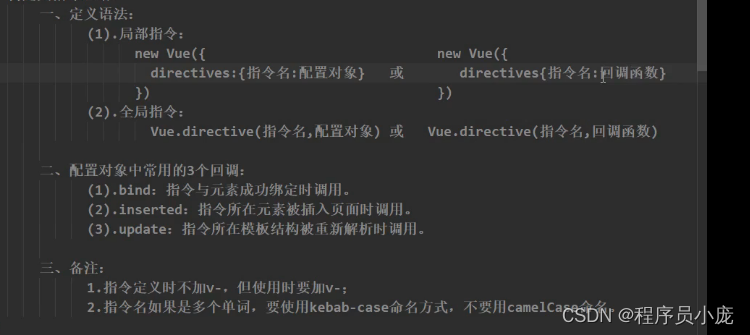
2、自定义指令案例(函数式及对象式)
需求1:定义个v-big指令,莉v-text功能类似,但会把绑定的数值放大10倍。
需求2: 定义一个v-fbind指令,和v-bind功能类似,但可以让其所绑定的input元素默认获取焦点。
<!DOCTYPE html>
<html lang="en">
<head>
<meta charset="UTF-8" />
<meta http-equiv="X-UA-Compatible" content="IE=edge" />
<meta name="viewport" content="width=device-width, initial-scale=1.0" />
<title>Document</title>
<script type="text/javascript" src="../js/vue.js"></script>
<script type="text/javascript" src="../js/dayjs.min.js"></script>
<style>
</style>
</head>
<body>
<div id="root">
<h1>当前的n值是:<span v-text="n"></span></h1>
<h1>放大10倍后的值<span v-big="n"></span></h1>
<button @click="n++">点我n+1</button>
</div>
<script type="text/javascript">
//阻止vue 在启动时生成生产提示
Vue.config.productionTip = false;
//自定义全局指令
Vue.directives('fbind',{
//指令与元素成功绑定时
bind(element,binding){
element.value=binding.value
},
//指令所在元素被插入页面时
inserted(element,binding){
element.focus()
},
//指令所在的模板被重新解析时
update(element,binding){
element.value=binding.value
}
})
const vm = new Vue({
el: "#root", //el用于指定当前vue实例为那个容器服务,值通常为css选择器字符串
data: {
n:1
},
//自定义big指令 局部指令
directives:{
//big何时调用?1、指令与元素成功绑定时 2、指令所在的模板被重新解析时(数据发生改变时)
//函数式
big(element,binding){
element.innerText=binding.value*10
},
//对象式
fbind:{
//指令与元素成功绑定时
bind(element,binding){
element.value=binding.value
},
//指令所在元素被插入页面时
inserted(element,binding){
element.focus()
},
//指令所在的模板被重新解析时
update(element,binding){
element.value=binding.value
}
}
}
});
</script>
</body>
</html>
20、生命周期
1.又名:生命周期回调函数、生命周期函数、生命周期钩子。
2.是什么:Vue在关键时刻帮我们调用的一些特殊名称的函数。
3.生命周期函数的名字不可更改,但函数的具体内容是程序员根据需求编写的。
4.生命周期函数中的this指向是vm 或 组件实例对象。
1、vm的生命周期
将要创建:调用beforeCreate函数
创建完毕:调用created函数。
将要挂载:调用beforeMount函数。
挂载完毕:调用mounted函数。
将要更新:调用beforeUpdate函数
更新完毕:调用updated函数。
将要销毁:调用beforeDestroy函数
销毁完毕:调用destroyed函数。

2、常用的生命周期钩子:
1.mounted: 发送ajax请求、启动定时器、绑定自定义事件、订阅消息等[初始化操作]
2.beforeDestroy: 清除定时器、解绑自定义事件、取消订阅消息等[收尾工作]。
3、关于销毁Vue实例
1.销毁后借助Vue开发者工具看不到任何信息。
2.销毁后自定义事件会失效,但原生DOM事件依然有效。
3.一般不会beforeDestroy操作数据,因为即便操作数据,也不会再触发更新流程了。
常用指令总结
v-bind:单向绑定解析表达式,可简写为 :xxx
v-model:双向数据绑定
v-for:遍历数组/对象/字符串
v-on:绑定事件监听,可简写为@
v-if:条件渲染(动态控制节点是否存存在)
V-else:条件渲染(动态控制节点是否存存在)
V-show:条件渲染 (动态控制节点是否展示)
v-text:向其所在的标签插入文本
v-text
1.作用:向其所在的节点中渲染文本内容。(会替换内容)
2.与插值语法的区别: v-text会替换掉节点中的内容,{[xx}}则不会
v-html: 和v-text一样,但能解析html标签
1.作用:向指定节点中渲染包含htm1结构的内容。
2.与插值语法的区别:
(1).v-htm1会替换掉节点中所有的内容,{{xx}}则不会
(2).v-htm1可以识别htm1结构。
3.严重注意: v-html有安全性问题!!! !
(1).在网站上动态渲染任意HTML是非常危险的,容易导致XSS攻击。
(2).一定要在可信的内容上使用v-htm1,永不要用在用户提交的内容上!
v-cloak (没有值) :
1.本质是一个特殊属性,Vue实例创建完毕并接管容器后,会厕掉v-cloak属性。
2.使用css配合v-cloak可以解决网速慢时页面展示出{[xxx}}的问题。
v-once(没有值)
1.v-once所在节点在初次动态渲染后,就视为静态内容了。
2.以后数据的改变不会引起v-once所在结构的更新,可以用于优化性能。
V-pre(没有值)
1.跳过其所在节点的编译过程。
2.可利用它跳过:没有使用指令语法、没有使用插值语法的节点,会加快编译
第 2 章:Vue 组件化编程
1、 模块与组件、模块化与组件化
1. 模块
1.理解: 向外提供特定功能的 js 程序, 一般就是一个 js 文件
2. 为什么: js 文件很多很复杂
3. 作用: 复用 js, 简化 js 的编写, 提高 js 运行效率
2. 组件
1.理解: 用来实现局部(特定)功能效果代码和资源的集合(html/css/js/image……)
2. 为什么: 一个界面的功能很复杂
3. 作用: 复用编码, 简化项目编码, 提高运行效率
3. 模块化
当应用中的 js 都以模块来编写的, 那这个应用就是一个模块化的应用。
4. 组件化
当应用中的功能都是多组件的方式来编写的, 那这个应用就是一个组件化的应用,。
2、非单文件组件
1、概念
非单文件组件:一个文件中包含有n个组件
单文件组件:一个文件中只包含有1一个组件
3、Vue中使用组件的三大步骤:
一、定义组件(创建组件)
二、注册组件
三、使用组体(写组件标签)
一、 如何定义一个组件?
使用Vue.extend(options)创建,其中options和new Vue(options)时传入的那个options几乎一样,但也有点区别:区别如下:
1、el不要写,为什么? 最终所有的组件都要经过一个vm的管理,由vm中的el决定服务哪个容器。
2、data必须写成函数,为什么? 避免组件被复用时,数据存在引用关系。
备注:使用template可以配置组件结构。
二、如何注册组件?
1.局部注册: 靠new Vue的时候传入components选项
2.全局注册:靠Vue.component('组件名,组件)
三、编写组件标签:
<school></schoo1>
例如:
<!DOCTYPE html>
<html lang="en">
<head>
<meta charset="UTF-8" />
<meta http-equiv="X-UA-Compatible" content="IE=edge" />
<meta name="viewport" content="width=device-width, initial-scale=1.0" />
<title>Document</title>
<script type="text/javascript" src="../js/vue.js"></script>
<script type="text/javascript" src="../js/dayjs.min.js"></script>
<style></style>
</head>
<body>
<div id="root">
<!-- 第三步:编写组件标签 -->
<school></school>
</div>
<script type="text/javascript">
//阻止vue 在启动时生成生产提示
Vue.config.productionTip = false;
//第一步:创建school组件
const school = Vue.extend({
// el: "#root",//组件定义时一定不要写el配置项,因为最终所有的组件都要被一个vm管理,由vm决定服务于哪个容器
data() {
return {
schoolName: "学校",
address: "xxxx",
};
},
template:`
<div>
<h2>学习名称:{{schoolName}}</h2>
<h2>学习地址:{{address}}</h2>
<button @click="showName">点我提示学校名</button>
</div>
`,
methods: {
showName(){
alert(this.schoolName)
}
},
});
//第一步:创建hello组件
const he = VUe.extend({
name:'cy',//可以使用name配置项指定组件在开发者工具中呈现的名字。
template:`
<div>
<h2>你好呀!{{name}}</h2>
</div>
`,
data(){
return {
name:'TOM'
}
}
})
//第二步:注册组件(全局注册)
Vue.component('hello',he)
new Vue({
el: "#root", //el用于指定当前vue实例为那个容器服务,值通常为css选择器字符串
//第二步:注册组件(局部注册)
components:{
school:school
//可以简写
// school
}
})
</script>
</body>
</html>
4、组件的几个注意事项
1.关于组件名:
一个单词组成:
第一种写法(首字母小写):school
第二种写法(首字母大写): school
多个单词组成:
第一种写法(kebab-case命名): my-school
第二种写法(CamelCase命名): MySchool (需要Vue脚手架支持)
备注:
(1).组件名尽可能回避HTML中己有的元素名称,例如: h2、H2都不行。
(2).可以使用name配置项指定组件在开发者工具中呈现的名字。
2.关于组件标签:
第一种写法:
第二种写法:
备注:不用使用脚手架时,会导致后续组件不能渲染
3.一个简写方式:
options:表示配置项 { }
const school = Vue,extend(options) 可简写: const school = options
如
//第一步:创建hello组件
const he ={
name:'cy',//可以使用name配置项指定组件在开发者工具中呈现的名字。
template:`
<div>
<h2>你好呀!{{name}}</h2>
</div>
`,
data(){
return {
name:'TOM'
}
}
}
5、组件的嵌套
<!DOCTYPE html>
<html lang="en">
<head>
<meta charset="UTF-8" />
<meta http-equiv="X-UA-Compatible" content="IE=edge" />
<meta name="viewport" content="width=device-width, initial-scale=1.0" />
<title>Document</title>
<script type="text/javascript" src="../js/vue.js"></script>
<script type="text/javascript" src="../js/dayjs.min.js"></script>
<style></style>
</head>
<body>
<div id="root">
<!-- 第三步:编写组件标签 -->
<school></school>
<hr />
</div>
<script type="text/javascript">
//阻止vue 在启动时生成生产提示
Vue.config.productionTip = false;
//第一步:创建student组件
const student = Vue.extend({
data() {
return {
studentname: "名字",
age: 18,
};
},
template:`
<div>
<h2>学生名称:{{studentname}}</h2>
<h2>学习年龄:{{age}}</h2>
</div>
`,
});
//第一步:创建school组件
const school = Vue.extend({
// el: "#root",//组件定义时一定不要写el配置项,因为最终所有的组件都要被一个vm管理,由vm决定服务于哪个容器
data() {
return {
schoolName: "学校",
address: "xxxx",
};
},
template:`
<div>
<h2>学习名称:{{schoolName}}</h2>
<h2>学习地址:{{address}}</h2>
<student></student> //引入student组件
<button @click="showName">点我提示学校名</button>
</div>
`,
methods: {
showName(){
alert(this.schoolName)
}
},
//注册组件(局部注册)嵌套组件
components:{
student
}
});
new Vue({
el: "#root", //el用于指定当前vue实例为那个容器服务,值通常为css选择器字符串
//第二步:注册组件(局部注册)
components:{
school:school,
//可以简写
// school,
}
})
</script>
</body>
</html>
6、关丁VueComponent:
1.school组件本质是一个名为VueComponent的构造函数,且不是程序员定义的,是Vue,extend生成的。
2.我们只需要写<school/>或<schoolx/school>,Vue解析时会帮我们创建school组件的实例对象,即Vue帮我们执行的: new VueComponent(options)。
3.特别注意: 每次调用Vue.extend,返回的都是一个全新的VueComponent!!!!
4.关于this指向:
(1).组件配置中:
data函数、methods中的函数、watch中的函数、computed中的函数 它们的this均是[VueComponent实例对象]
(2).new Vue()配置中:
data函数、methods中的函数、watch中的函数、computed中的函数 它们的this均是[Vue实例对象]
5.VueComponent的实例对象,以后简称vc (也可称之为: 组件实例对象)。
Vue的实例对象,以后简称vm。
7、一个重要的内置关系:
1.一个重要的内置关系:
VueComponent.prototype._proto_=== Vue.prototype
2.为什么要有这个关系:
让组件实例对象 (vc) 可以访问到 Vue原型上的属性、方法。
8、单文件组件
1. 一个.vue 文件的组成(3 个部分)
// 1、模板页面
<template>
<!-- 组件的结构 -->
<div>
</div>
</template>
// 2、JS模板对象
<script>
//组件交互相关的代码(数据、方法)
</script>
// 3、样式
<style >
/* //组件的样式 */
</style>
如:School.vue
// 1、模板页面
<template>
<!-- 组件的结构 -->
<div class="demo">
<h2>学习名称:{{schoolName}}</h2>
<h2>学习地址:{{address}}</h2>
<button @click="showName">点我提示学校名</button>
</div>
</template>
// 2、JS模板对象
<script>
//组件交互相关的代码(数据、方法)
export default {
name:'School',
data() {
return {
schoolName: "学校",
address: "xxxx",
};
},
methods: {
showName(){
alert(this.schoolName)
}
},
}
</script>
// 3、样式
<style >
/* //组件的样式 */
.demo{
background-color: aliceblue;
}
</style>
Student.vue
// 1、模板页面
<template>
<!-- 组件的结构 -->
<div class="demo">
<h2>学生姓名{{name}}</h2>
<h2>学生年龄{{age}}</h2>
<button @click="showName">点我提示学名字</button>
</div>
</template>
// 2、JS模板对象
<script>
//组件交互相关的代码(数据、方法)
export default {
name:'School',
data() {
return {
name: "谢谢谢",
age: 19,
};
},
methods: {
showName(){
alert(this.schoolName)
}
},
}
</script>
// 3、样式
<style >
/* //组件的样式 */
.demo{
background-color: aliceblue;
}
</style>
App.vue
<template>
<div>
<School></School>
<Student></Student>
</div>
</template>
<script>
//引入组件
import School from '01初始vue/单文件组件/School'
import Student from '01初始vue/单文件组件/Student'
export default {
name:'App',
//注册组件
components:{
School,
Student
}
}
</script>
<style>
</style>
main.js
import App from '01初始vue/单文件组件/App'
new Vue({
el:'#root',
template:`<App></App>`,
components:{
App
}
})
index.html
<!DOCTYPE html>
<html lang="en">
<head>
<meta charset="UTF-8">
<meta http-equiv="X-UA-Compatible" content="IE=edge">
<meta name="viewport" content="width=device-width, initial-scale=1.0">
<title>Document</title>
</head>
<body>
<!-- 准备一个容器 -->
<div id="root"></div>
<!-- <script type="text/javaScript" src="../../js/vue.js"></script>
<script type="text/javaScript" src="./main.js"></script> -->
</body>
</html>
第 3 章:使用 Vue 脚手架
1 初始化脚手架
1、说明
1.Vue 脚手架是 Vue 官方提供的标准化开发工具(开发平台)。
2. 最新的版本是 4.x。
3. 文档: https://cli.vuejs.org/zh/。
2 、具体步骤
第一步(仅第一次执行):全局安装@vue/cli。
npm install -g @vue/cli
第二步:切换到你要创建项目的目录,然后使用命令创建项目
vue create xxxx
第三步:启动项目
npm run serve
备注:
1.如出现下载缓慢请配置 npm 淘宝镜像:
npm config set registry https://registry.npm.taobao.org
2.Vue 脚手架隐藏了所有 webpack 相关的配置,若想查看具体的webpakc 配置,请执行:
vue inspect > output.js
3 模板项目的结构

4、关于不同版本的Vue:
1.vue.js与vue.runtime.xxx.js的区别:
(1).vue.js是完整版的Vue,包含: 楼心功能+模板解析器。
(2).vue.runtime.xxx.js是运行版的Vue,只包含: 核心功能;没有模板解析器.
2.因为vue.runtime.xxx.js没有模板解析器,所以不能使用template配置项,需要使用render函数接收到的createElement函数去指定具体内容。
2 ref 与 props
1、ref
1.被用来给元素或子组件注册引用信息I(id的替代者)
2.应用在htm1标签上获取的是真实DOM元素,应用在组件标签上是组件实例对象 (vc)
3.使用方式:
打标识: <h1 ref="xxx">.....</h1> 或<School ref="xxx"></Schoo1>
获取: this.$refs.xxx
如:
<template>
<div>
<School></School>
<Student ref="stud"></Student>
<h1 v-text="msg" ref="title"></h1>
<button @click="showDOM">点我输入h2的DOM元素</button>
</div>
</template>
<script>
//引入组件
import School from '@/components/School'
import Student from '@/components/Student'
export default {
name:'App',
//注册组件
components:{
School,
Student
},
data(){
return{
msg:'欢迎回来!'
}
},
methods:{
showDOM(){
console.log(this.$refs.title) //真实的DOM元素<h1>欢迎回来!</h1>
console.log(this.$refs.stud) //VC的组件实例对象
}
}
}
</script>
<style>
</style>
2、props
1.作用:用于父组件给子组件传递数据
2. 读取方式一: 只指定名称
props: ['name', 'age', 'setName']
3.读取方式二: 指定名称和类型
props: {
name: String,
age: Number,
setNmae: Function
}
4.读取方式三: 指定名称/类型/必要性/默认值
props: {
name: {type: String, required: true, default:xxx},
}
5.传递数据:
<Student name="xxx" age=18/>
备注: props是只读的,Vue底层会监测你对props的修改,如果进行了修改,就会发出警告,若业务需求确实需要修改,那么请复制props的内容到data中一份,然后去修改data中的数据。
如:
传值
<template>
<div>
<Student name='学生1' age='19'/> //传值
</div>
</template>
<script>
//引入组件
import Student from '@/components/Student'
export default {
name:'App',
//注册组件
components:{
Student
}
}
</script>
<style>
</style>
接收值
// 1、模板页面
<template>
<!-- 组件的结构 -->
<div class="demo" >
<h2 v-text="msg"></h2>
<h2>学生姓名:{{name}}</h2>
<h2>学生年龄:{{myAge}}</h2>
<button @click="updateage">点我修改年龄</button>
</div>
</template>
// 2、JS模板对象
<script>
//组件交互相关的代码(数据、方法)
export default {
name:'Student',
data() {
return {
msg:'我是学生',
myAge:this.age
};
},
methods:{
updateage(){
this.myAge++
}
},
//方式一:简单接受
// props:['name','age']
//方式二:接收的同时对数据进行类型限制
/* props:{
name:String,
age:Number
} */
//方式三:接收的同时指定名称/类型/必要性/默认值
props:{
name:{
type:Stirng,//name的类型是字符串
required:true //name是必要的
},
age:{
type:Number,
default:99//默认值
}
}
}
</script>
// 3、样式
<style >
/* //组件的样式 */
.demo{
background-color: aliceblue;
}
</style>
3 混入minxin
功能:可以把多个组件共用的配置提取成一个混入对象
使用方式:
第一步自定义混合,例如:
{
data()(....},
methods:{....]
}
第二步使用混入,例如:
(1).全局混入: Vue.mixin(xxx)
(2).局部混入: mixins:[‘xxx’]
如:
第一步:自定义混合mixin.js文件
export const hunhe={
methods: {
showName(){
alert(this.schoolName)
}
}
}
第二步:使用混入
<script>
// 局部引用
import {hunhe} from '../minxin'
//组件交互相关的代码(数据、方法)
export default {
name:'School',
data() {
return {
schoolName: "学校",
address: "xxxx",
};
},
mixins:[hunhe]
}
</script>
再main.js中全局引入
//引入Vue
import Vue from 'vue'
//引入App
import App from './App.vue'
import { hunhe } from './minxin'
//关闭Vue的生产提示
Vue.config.productionTip = false
//全局引入
Vue.mixin(hunhe)
//创建VM
new Vue({
render: h => h(App),
}).$mount('#app')
4 插件
1、功能:
用于增强Vue
2、本质:
包含install方法的一个对象,install的第一个参数是Vue,第二个以后的参数是插件使用者传递的数据。
3、定义插件:
对象.install = function (Vue, options) {
// 1。添加全局过滤器
Vue.filter(....)
// 2.添加全局指令
Vue.directive(....)
// 3。配置全局混入(合
)Vue.mixin(....)
// 4。添加实例方法
Vue.prototype.$myMethod = function () [...}
Vue.prototype.$myProperty = xxxx
}
如:
export default {
install(Vue,x,y,z){
console.log(x,y,z)
//全局过滤器
Vue.filter('mySlice',function(value){
return value.slice(0,4)
})
//定义全局指令
Vue.directive('fbind',{
//指令与元素成功绑定时(一上来)
bind(element,binding){
element.value = binding.value
},
//指令所在元素被插入页面时
inserted(element,binding){
element.focus()
},
//指令所在的模板被重新解析时
update(element,binding){
element.value = binding.value
}
})
//定义混入
Vue.mixin({
data() {
return {
x:100,
y:200
}
},
})
//给Vue原型上添加一个方法(vm和vc就都能用了)
Vue.prototype.hello = ()=>{alert('你好啊')}
}
}
4、再main.js中使用插件:
Vue.use(插件名)
如:
//引入Vue
import Vue from 'vue'
//引入App
import App from './App.vue'
//关闭Vue的生产提示
Vue.config.productionTip = false
//引入插件
import plugins from './plugins'
//使用插件
Vue.use(plugins)
//创建VM
new Vue({
render: h => h(App),
}).$mount('#app')
5、scoped样式
作用:让样式在局部生效,防止冲突。
写法:
style scoped>
//样式
</style>
6、组件的自定义事件
App.vue
<template>
<div>
<!-- 通过父组件给子组件传递函数类型的props实现:子给父传递数据 -->
<School :getSchoolName='getSchoolName'/>
<!-- 写法一:使用@或v-on:通过父组件给子组件绑定一个自定义事件实现:子给父传递数据 -->
<Student v-on:cy="getStudentName"/>
<!-- 只在第一次起作用 -->
<Student v-on:cy.once="getStudentName"/>
<!-- 写法二:使用ref:通过父组件给子组件绑定一个自定义事件实现:子给父传递数据 -->
<Student ref='student'/>
</div>
</template>
<script>
//引入组件
import Student from '@/components/Student'
import School from './components/School.vue'
export default {
name:'App',
//注册组件
components:{
Student,
School,
},
methods:{
getSchoolName(name){
return this.name
},
getStudentName(name){
console.log("cy事件被触发了")
return this.name
}
},
mounted(){
// 绑定自定义事件
this.$refs.Student.$on('cy',this.getStudentName)
// 只在第一次起作用
this.$refs.Student.$once('cy',this.getStudentName)
}
}
</script>
<style>
</style>
Student.vue
<template>
<div class="test">
<h2>学生姓名:{{name}}</h2>
<h2>学生性别:{{sex}}</h2>
<button @click="sendStudentName">把学生名给App</button>
<button @click="unbind">解绑cy事件</button>
<button @click="death">销毁了当前组件就的实例</button>
</div>
</template>
<script>
export default {
name:'Student',
data() {
return {
name:'张三',
sex:'男'
}
},
methods:{
sendStudentName(){
//触发Student组件实例身上的cy事件
this.$emit('cy',this.name)
},
unbind(){
//解绑自定义事件(只使用与一个自定义事件)
this.$off('cy')
//解绑多个自定义事件
this.$off(['cy','自定义事件2','xxx'])
this.$off()//所有的自定义事件全部解绑
},
death(){
this.$destroy()//销毁了当前组件就的实例,销毁后该组件实例的自定义事件全部不奏效
}
}
}
</script>
<style scoped>
.test{
background-color: bisque;
}
</style>
7、全局事件总线 (GlobalEventBus):任意组件间通信
1.一种组件间通信的方式,适用于任意组件间通信。
2.安装全局事件总线:
new Vue({
。。。。。。。
beforeCreate(){
Vue.prototype.$bus = this //安装全局事件总线,$bus就是当前应用的vm
},
......
})
3.使用事件总线:
-
接收数据:A组件想接收数据,则在A组件中给Sbus绑定自定义事件,事件的回调留在A组件自身.
methods(){ demo(data){......} } .... mounted() { this.$bus.$on("xxxx',this .demo) } -
提供数据:
this.$bus.$emit("xxxx’,数据)
4.最好在beforeDestroy钩子中,用$off去解绑当前组件所用到的事件。
如:
在main.js中 安装全局事件总线
//引入Vue
import Vue from 'vue'
//引入App
import App from './App.vue'
//关闭Vue的生产提示
Vue.config.productionTip = false
//创建VM
new Vue({
render: h => h(App),
beforeCreate(){
Vue.prototype.$bus=this //安装全局事件总线
}
}).$mount('#app')
将学生名传递给学校组件
Student.vue
<template>
<div class="test">
<h2>学生姓名:{{name}}</h2>
<h2>学生性别:{{sex}}</h2>
<button @click="sendStudentName">把学生名给School组件</button>
</div>
</template>
<script>
export default {
name:'Student',
data() {
return {
name:'张三',
sex:'男'
}
},
methods:{
sendStudentName(){
//触发Student组件实例身上的cy事件
this.$bus.$emit('hello',this.name)
}
}
}
</script>
<style scoped>
.test{
background-color: bisque;
}
</style>
School.vue组件
<template>
<div class="demo">
<h2>学校名称:{{name | mySlice}}</h2>
<h2>学校地址:{{address}}</h2>
</div>
</template>
<script>
export default {
name:'School',
data() {
return {
name:'尚硅谷atguigu',
address:'北京',
}
},
mounted(){
this.$bus.$on("hell",(data)=>{
console.log("我是School组件,收到了数据",data)
})
},
//beforeDestroy钩子中,用$off去解绑当前组件所用到的事件。
beforeDestroy(){
this.$bus.$off('hello')
}
}
</script>
<style >
.demo{
background-color: aqua;
}
</style>
8、消息订阅与发布
1 理解
- 这种方式的思想与全局事件总线很相似
- 它包含以下操作:
(1) 订阅消息 --对应绑定事件监听
(2) 发布消息 --分发事件
(3) 取消消息订阅 --解绑事件监听 - 需要引入一个消息订阅与发布的第三方实现库: PubSubJS
2 使用 PubSubJS
- 在线文档: https://github.com/mroderick/PubSubJS
- 下载: npm install -S pubsub-js
- 相关语法
(1) import PubSub from 'pubsub-js' // 引入
(2) PubSub.subscribe(‘msgName’, functon(msgName, data){ })
(3) PubSub.publish(‘msgName’, data): 发布消息, 触发订阅的回调函数调用
(4) PubSub.unsubscribe(token): 取消消息的订阅
3、总结:
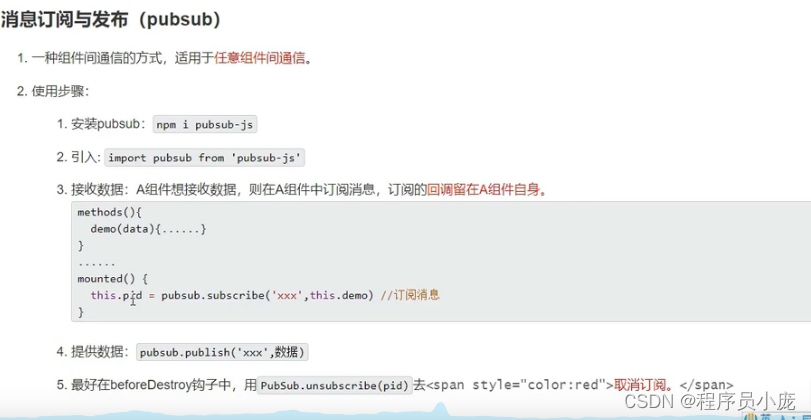
如:
Student.vue
<template>
<div class="test">
<h2>学生姓名:{{name}}</h2>
<h2>学生性别:{{sex}}</h2>
<button @click="sendStudentName">把学生名给School组件</button>
</div>
</template>
<script>
import pubsub from 'pubsub-js'
export default {
name:'Student',
data() {
return {
name:'张三',
sex:'男'
}
},
methods:{
sendStudentName(){
// //触发Student组件实例身上的cy事件
// this.$bus.$emit('hello',this.name)
pubsub.publish('hello',666)
}
}
}
</script>
<style scoped>
.test{
background-color: bisque;
}
</style>
School.vue
<template>
<div class="demo">
<h2>学校名称:{{name | mySlice}}</h2>
<h2>学校地址:{{address}}</h2>
</div>
</template>
<script>
// 引入
import pubsub from 'pubsub-js'
export default {
name:'School',
data() {
return {
name:'尚硅谷atguigu',
address:'北京',
}
},
mounted(){
// this.$bus.$on("hell",(data)=>{
// console.log("我是School组件,收到了数据",data)
// })
this.pubId= pubsub.subscribe('hello',(msgName,data)=>{
console.log("有人发布了hello消息,hello消息的回调执行了",msgName,data)
})
},
beforeDestroy(){
// this.$bus.$off('hello')
pubsub.unsubscribe(this.pubId)
}
}
</script>
<style >
.demo{
background-color: aqua;
}
</style>
nextTick
1.语法: this.$nextTick(回调函数)
2.作用: 在下一次 DOM 更新结束后执行其指定的回调
3.什么时候用: 当改变数据后,要基于更新后的新DOM进行某些操作时,要在nextTick所指定的回调函数中执行.
9 、Vue封装的过度与动画
1、作用:在插入、跟新或移除DOM元素时,在合适的时候给元素添加样式类名
2、图示
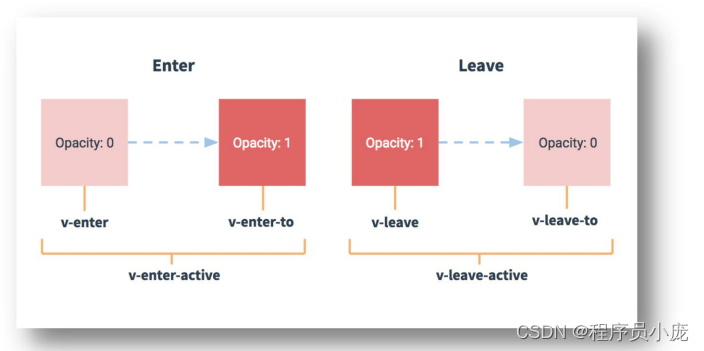
3、写法
- 准备好样式:
元素进入的样式
1、v-enter:进入的起点
2、v-enter-axtive:进入过程中
3、v-enter-to:进入的终点
元素离开的样式
1、v-leave:离开的起点
2、v-leave-active:离开过程中
3、v-leave-to:离开的终点
- 使用包裹要过渡的元素,并配置name属性:
<transition appear name='hello'>
<h1 v-show="isShow">你好呀!</h1>
</transition>
- 备注:若有多个元素需要过度,则需要使用 transition-group,且每个元素都要指定key值
如:
<template>
<div>
<button @click="isShow =!isShow">显示/隐藏</button>
<!-- <h1 v-show="isShow" class="come">你好呀!</h1> -->
<transition appear name='hello'>
<h1 v-show="isShow">你好呀!</h1>
</transition>
<!-- transition-group 可以实现多个元素过度 -->
<transition-group appear name='hello '>
<h1 v-show="isShow" key="1">你好呀!</h1>
<h1 v-show="isShow" key='2'>辰逸</h1>
</transition-group>
</div>
</template>
<script>
export default ({
name:'Test2',
data(){
return{
isShow:true
}
}
})
</script>
<style scoped>
h1{
background-color: orange;
/* transition: 05s linear; */
}
//封装的过度
/* 进入的起点、离开的终点*/
.hello-enter,.hello-leave-to{
transform: translateX(-100%);
}
/* 进入的终点 、离开的起点*/
.hello-enter-to,.hello-leave{
transform: translateX(0);
}
.hello-enter-active,.hello-leave-active{
transition: 05s linear;
}
//封装的动画,过度和动画使用一个就可以
.v-enter-active{
animation:cy 1s
}
.v-leave-active{
animation: cy 1s reverse;
}
@keyframes cy{
from{
transform: translateX(-100px);
}
to{
transform: translateX(-0px);
}
}
</style>
- 第三方动画库
https://www.npmjs.com/网站上搜索animate.css
<template>
<div>
<button @click="isShow =!isShow">显示/隐藏</button>
<!-- <h1 v-show="isShow" class="come">你好呀!</h1> -->
<transition appear name='hello'>
<h1 v-show="isShow">你好呀!</h1>
</transition>
<!-- transition-group 可以实现多个元素过度 -->
<transition-group
appear
name='animate_animated animate_bounce'
enter-active-class="animate_swing"
leave-active-class="animate_backOutUp"
>
<h1 v-show="isShow" key="1">你好呀!</h1>
<h1 v-show="isShow" key='2'>辰逸</h1>
</transition-group>
</div>
</template>
<script>
//引入animate
import 'animate.css'
export default ({
name:'Test2',
data(){
return{
isShow:true
}
}
})
</script>
<style scoped>
h1{
background-color: orange;
/* transition: 05s linear; */
}
</style>
第 4 章:Vue 中的 ajax
1 解决开发环境 Ajax 跨域问题(代理服务器)

2、vue脚手架配置代理
方法一
在vue.config.s中添加如下配置:
devServer:{
proxy:'http://localhost:5000'
}
说明:
- 优点:配置简单,请求资源时直接发给前端 (8080) 即可。
- 缺点:不能配置多个代理,不能灵活的控制请求是否走代理
- 工作方式:若按照上述配置代理,当请求了前端不存在的资源时,那么该请求会转发给服务器(优先匹配前端资源)
方法二:
编写vue.config.js配置具体代理规则
devServer: {
proxy: {
'/cy': { //匹配所有以'/cy'开头的请求路径
target: 'http://localhost:5000',//代理目标的基础路径
pathRewrite:{'^/cy':''}, //去掉请求地址中的/cy
ws: true, //用于支持websocket
changeOrigin: true //用于控制请求头中的host值
},
'/demo': {//匹配所有以'/demo'开头的请求路径
target: 'http://localhost:5001',//代理目标的基础路径
pathRewrite:{'^/demo':''},//去掉请求地址中的/demo
ws: true, //用于支持websocket
changeOrigin: true //用于控制请求头中的host值 为true时请求头的host为:localhost:5000,为false时,localhost:8080 默认为true
},
}
}
如:
vue.config.js
const { defineConfig } = require('@vue/cli-service')
module.exports = defineConfig({
transpileDependencies: true,
lintOnSave:false , //关闭语法检查
//开启代理服务器(方式一)
/* devServer:{
proxy:'http://localhost:5000'
}, */
//开启代理服务器(方式二)
devServer: {
proxy: {
'/cy': {
target: 'http://localhost:5000',
pathRewrite:{'^/cy':''}, //去掉请求地址中的/cy
ws: true, //用于支持websocket
changeOrigin: true //用于控制请求头中的host值
},
'/demo': {
target: 'http://localhost:5001',
pathRewrite:{'^/demo':''},//去掉请求地址中的/demo
ws: true, //用于支持websocket
changeOrigin: true //用于控制请求头中的host值
},
}
}
})
App.vue
<template>
<div>
<button @click="getSutdents">获取学生信息</button>
<button @click="getCars">获取汽车信息</button>
</div>
<!--
http://localhost:5000/students
http://localhost:5001/cars
-->
</template>
<script>
import axios from 'axios'
export default {
name:'App',
methods:{
getSutdents(){
axios.get('http://localhost:8080/cy/students').then(
response=>{
console.log("请求成功了",response.data)
},
error=>{
console.log('请求失败了',error.message)
}
)
},
getCars(){
axios.get('http://localhost:8080/demo/cars').then(
response=>{
console.log("请求成功了",response.data)
},
error=>{
console.log('请求失败了',error.message)
}
)
}
}
}
</script>
3、插槽
1.作用:
让父组件可以向子组件指定位置插入html结构,也是一种组件间通信的方式 适用于 父组件 ===>子组件
2.分类:
默认插槽、具名插槽、作用域插槽
3.使用方式:
1、默认插槽
父组件中:
<Category>
<div>html结构1</div>
</Category>
子组件中:
<template>
<div>
<!-- 定义插槽 -->
<slot>插槽默认内容...</slot>
</div>
</template>
2、具名插槽
父组件中
<Category>
<template slot="center"》
<div>htm1结构1</div>
</template>
<template v-slot:footer>
<div>html结构2</div>
</template>
</Category>
子组件中:
<template>
<div>
<!--定义插槽 -->
<slot name="center">插槽默认内容...</slot>
<slot name="footer">插槽默认内容...</slot>
</div>
</template>
3.作用域插槽:
1.理解:
数据在组件的自身,但根据数据生成的结构需要组件的使用者来决定。 (games数据在Category组件中,但使用数据所遍历出来的结构由App组件决定)
2.具体编码
父组件中:
<Category>
<template scope="scopeData">
<!-- 生成的是u1列表 -->
<ul>
<li v-for="g in scopeData.games” :key="g">((g)}</1i>
</u1>
</template>
</Category>
<Category>
<template slot-scope="scopeData">
<!-- 生成的是h4标题 -->
<h4 v-for="g in scopeData.games” :key="g">(g]]</h4>
</template>
</Category>
子组件中,
<template>
<div>
<slot :games="games"></slot>
</div>
</template>
<script>
export default {
name:'Category",
props:['title'],
//数据在子组件自身
data(){
return {
games:['红色警戒”,穿越火线,劲舞团,超级玛丽]
},
</script>
第 5 章:vuex
1、理解 vuex
1 vuex 是什么
- 概念:专门在 Vue 中实现集中式状态(数据)管理的一个Vue 插件,对vue应用中多个组件的共享状态进行集中式的管理(读/写),也是一种组件间通信的方式,且适用于任意组件间通信。
- Github 地址: https://github.com/vuejs/vuex
2、什么时候使用 Vuex
1.多个组件依赖于同一状态(数据)
2.来自不同组件的行为需要变更同一状态(数据)
3、搭建环境
1、创建文件:src/store/index.js
//该文件用于创建vuex中最为核心的store
// 引入vue核心库
import Vue from 'vue'
//引入vuex
import Vuex from 'vuex'
// 应用Vuex插件
Vuex.usr(Vuex)
//准备action-用于响应组件中的动作
const actions={}
//准备mutations-用于操作数据(state)
const mutations={}
//准备state-用于存储数据
const state ={}
// 创建并暴露store
export default new Vuex.Store({
actions,
mutations,
state
})
2、在mian.js中创建vm时传入store配置项
//引入Vue
import Vue from 'vue'
//引入App
import App from './App.vue'
//关闭Vue的生产提示
Vue.config.productionTip = false
//引入插件
import vueResource from 'vue-resource'
// 引入store
import store from './store/index'
// 使用插件
Vue.use(vueResource)
//创建vm
new Vue({
el:'#app',
render: h => h(App),
store
})
4、基本使用
1、初始化数据、配置actions、配置mutations,操作文件store.js
//该文件用于创建vuex中最为核心的store
// 引入vue核心库
import Vue from 'vue'
//引入vuex
import Vuex from 'vuex'
// 应用Vuex插件
Vuex.usr(Vuex)
//准备action-用于响应组件中的动作
const actions={
// jia(miniStore,value){
// miniStore.commit('JIA',value)
// },
// jian(miniStore,value){
// miniStore.commit('JIAN',value)
// },
jiaOdd(miniStore,value){
if(miniStore.state.sum % 2){
miniStore.commit('JIA',value)
}
},
jiaWait(miniStore,value){
setTimeout(() => {
miniStore.commit('JIA',value)
}, 500);
},
}
//准备mutations-用于操作数据(state)
const mutations={
JIA(state,value){
state.sum+=value
},
JIAN(state,value){
state.sum-=value
}
}
//准备state-用于存储数据
const state ={
sum:0,//当前和
}
// 创建并暴露store
export default new Vuex.Store({
actions,
mutations,
state
})
2、组件中读取vuex中的数据
$store.state.sum
3.组件中修改vuex中的数据:
$store.dispatch('action中的方法名,数据) 或 $store.commit('mutations中的方法名',数据)
备注: 若没有网络请求或其他业务逻辑,组件中也可以越过actions,即不写dispath,直接编写commit
如:
<template>
<div>
<h1>当前求和为:{{$store.state.sum}}</h1>
<select v-model='n'>
<option :value="1">1</option>
<option :value="2">2</option>
<option :value="3">3</option>
</select>
<button @click='increment'>+</button>
<button @click='decrement'>-</button>
<button @click='incrementOdd'>当前求和为奇数时加</button>
<button @click='incrementWait'>等一等再加</button>
</div>
</template>
<script>
export default {
name:'Category',
date(){
return{
// sum:0,//当前和
n:1,//用户选择的数字
}
},
methods:{
increment(){
// this.sum+this.n
//this.$store.dispatch('jia',this.n)
//没有业务逻辑可以dispatch 直接写成
this.$store.commit('JIA',n)
},
decrement(){
// this.sum-=this.n
this.$store.dispatch('jian',this.n)
},
incrementOdd(){
// if(this.sum % 2){
// this.sum+=this.n
// }
this.$store.dispatch('jiaOdd',this.n)
},
incrementWait(){
// setTimeout(() => {
// this.sum+this.n
// }, 500);
this.$store.dispatch('jiaWait',this.n)
},
}
}
</script>
<style>
</style>
5、getters的使用
1.概念:
当state中的数据需要经过加工后再使用时,可以使用getters加工。
2.在store.js 中追加getters 配置
......
const getters = {
bigSum(state){
return state.sum * 10
}
}
//创建并暴露store
export default new Vuex.Store({
......
getters
})
3.组件中读取数据:
$store.getters.bigSum
如:
<h3>当前求和放大十倍后为:{{$store.getters.bigSum}}</h3>
6、四个map方法的使用
1.mapstate方法:
用于帮助我们映射state 中的数据为计算属性
computed:{
//借助mapState生成计算属性: sum、schoo1、subject (对象写法)
...mapState((sum:'sum",school: 'school",subject:'subject"}),
//借助mapstate生成计算属性: sum、schoo1、subject (数组写法)
...mapState(["sum',"school',"subject"]),
}
2.mapGetters方法:
用于帮助我们映射getters 中的数据为计算属性
computed:{
//借助mapGetters生成计算属性。bigSum (对象写法)
...mapGetters({bigSum;"bigSum"}).
//借助mapGetters生成计算属性: bigSum (数组写法)
...mapGetters(['bigSum"])
}
3.mapActions方法:
用于帮助我们生成与actions 对话的方法,即: 包含$store.dispatch(xxx)的函数
methods:{
//靠mapActions生成:incrementOdd、incrementWait (对象形式)
..mapActions(fincrementOdd:'jiaOdd',incrementWait:"jiaWait'})
//靠mapActions生成:incrementOdd、incrementWait (数组形式)
...mapActions(["jiaOdd","jiawait"])
}
4.mapMutations方法:
用于帮助我们生成与mutations对话的方法,即:包含$store,commit(xxx)的函数
methods:(
//靠mapActions生成: increment、decrement (对象形式)
...mapMutations({increment:'JIA',decrement:'JIAN'}),
//靠mapMutations生成:JIA、JIAN (对象形式)
...mapMutations(['JIA',JIAN']),
}
备注: mapActions与mapMutations使用时,若需要传递参数需要: 在模板中绑定事件时传递好参数,否则参数是事件对象。
如:
<template>
<div>
<h1>当前求和为:{{sum}}</h1>
<h3>当前求和放大10倍为:{{bigSum}}</h3>
<h3>我在{{school}},学习{{subject}}</h3>
<select v-model.number="n">
<option value="1">1</option>
<option value="2">2</option>
<option value="3">3</option>
</select>
<button @click="increment(n)">+</button>
<button @click="decrement(n)">-</button>
<button @click="incrementOdd(n)">当前求和为奇数再加</button>
<button @click="incrementWait(n)">等一等再加</button>
</div>
</template>
<script>
import {mapState,mapGetters,mapMutations,mapActions} from 'vuex'
export default {
name:'Count',
data() {
return {
n:1, //用户选择的数字
}
},
computed:{
//靠程序员自己亲自去写计算属性
/* sum(){
return this.$store.state.sum
},
school(){
return this.$store.state.school
},
subject(){
return this.$store.state.subject
}, */
//借助mapState生成计算属性,从state中读取数据。(对象写法)
// ...mapState({he:'sum',xuexiao:'school',xueke:'subject'}),
//借助mapState生成计算属性,从state中读取数据。(数组写法)
...mapState(['sum','school','subject']),
/* ******************************************************************** */
/* bigSum(){
return this.$store.getters.bigSum
}, */
//借助mapGetters生成计算属性,从getters中读取数据。(对象写法)
// ...mapGetters({bigSum:'bigSum'})
//借助mapGetters生成计算属性,从getters中读取数据。(数组写法)
...mapGetters(['bigSum'])
},
methods: {
//程序员亲自写方法
/* increment(){
this.$store.commit('JIA',this.n)
},
decrement(){
this.$store.commit('JIAN',this.n)
}, */
//借助mapMutations生成对应的方法,方法中会调用commit去联系mutations(对象写法)
...mapMutations({increment:'JIA',decrement:'JIAN'}),
//借助mapMutations生成对应的方法,方法中会调用commit去联系mutations(数组写法)
// ...mapMutations(['JIA','JIAN']),
/* ************************************************* */
//程序员亲自写方法
/* incrementOdd(){
this.$store.dispatch('jiaOdd',this.n)
},
incrementWait(){
this.$store.dispatch('jiaWait',this.n)
}, */
//借助mapActions生成对应的方法,方法中会调用dispatch去联系actions(对象写法)
...mapActions({incrementOdd:'jiaOdd',incrementWait:'jiaWait'})
//借助mapActions生成对应的方法,方法中会调用dispatch去联系actions(数组写法)
// ...mapActions(['jiaOdd','jiaWait'])
},
mounted() {
const x = mapState({he:'sum',xuexiao:'school',xueke:'subject'})
console.log(x)
},
}
</script>
<style lang="css">
button{
margin-left: 5px;
}
</style>
7.模块化+命名空间
1.目的:
让代码更好维护,让多种数据分类更加明确
2.修改store.js
const countAbout = {
namespaced;true,//开启命名空间state:(x:1),
mutations:(...}
actions:[..},
getters: {
bigSum(state){
return state.sum * 10
}
}
}
const personAbout = {
namespaced;true,//开启命名空间
state:{ ... },
mutations: { ...},
actions:{ ...}
}
const store = new Vuex.Store(
modules:{
countAbout.
personAbout
}
})
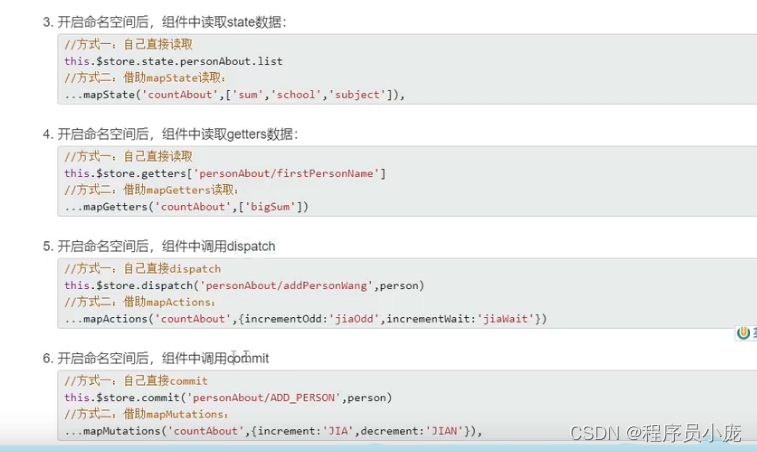
如:
第 6 章:vue-router路由
1 vue-router 的理解
vue 的一个插件库,专门用来实现 SPA 应用
2 对 SPA 应用的理解
- 单页 Web 应用(single page web application,SPA)。
- 整个应用只有一个完整的页面。
- 点击页面中的导航链接不会刷新页面,只会做页面的局部更新。
- 数据需要通过 ajax 请求获取。
3 路由的理解
1. 什么是路由?
- 一个路由就是一组映射关系(key - value)
- key 为路径, value 可能是 function 或 component
2. 路由分类
1. 后端路由:
- 理解:value 是 function, 用于处理客户端提交的请求。
- 工作过程:服务器接收到一个请求时, 根据请求路径找到匹配的函数来处理请求, 返回响应数据。
2. 前端路由:
- 理解:value 是 component,用于展示页面内容。
- 工作过程:当浏览器的路径改变时, 对应的组件就会显示。
4 路由的基本使用
1.安装vue-router,命令:
npm i vue-router@3
2.应用插件:
Vue.use(VueRouter)
如:
//引入Vue
import Vue from 'vue'
//引入App
import App from './App.vue'
//关闭Vue的生产提示
Vue.config.productionTip = false
//引入vueRouter
import VueRouter from 'vue-router'
//引入路由器
import router from './router/index'
//应用插件
Vue.use(VueRouter)
//创建vm
new Vue({
el:'#app',
render: h => h(App),
router:router
})
3.编写router配置项:
//该文件专门用于创建整个应用的路由器
import VueRouter from 'vue-router'
//引入组件
import About from '@/components/About'
import Home from '../components/Home'
//创建并暴露路由器,去管理一组一组的路由规则
export default new VueRouter({
routes:[
{
path:'/about',
component:About
},
{
path:'/home',
component:Home
}
]
})
4.实现切换(active-class可配置高亮样式)
<router-link active-class="active" to="/about">About</router-link>
5.指定展示位置
<router-view></router-view>
如:
<template>
<div>
<div class="row">
<div class="col-xs-offset-2 col-xs-8">
<div class="page-header"><h2>Vue Router Demo</h2></div>
</div>
</div>
<div class="row">
<div class="col-xs-2 col-xs-offset-2">
<div class="list-group">
<!-- 原始html中我们使用a标签实现页面的跳转 -->
<!-- <a class="list-group-item active" href="./about.html">About</a>
<a class="list-group-item" href="./home.html">Home</a> -->
<!--Vue中借助router-lick标签实现路由的切换 -->
<router-link class="list-group-item " active-class="active" to="/about">About</router-link>
<router-link class="list-group-item" active-class="active" to="/home">Home</router-link>
</div>
</div>
<div class="col-xs-6">
<div class="panel">
<div class="panel-body">
<!-- 指定组件的呈现位置 -->
<router-view></router-view>
</div>
</div>
</div>
</div>
</div>
</template>
<script>
export default {
name:'App'
}
</script>
<style scoped>
</style>
6.几个注意点
1.路由组件通常存放在pages 文件夹,一般组件通常存放在components 文件夹
2.通过切换,“隐藏”了的路由组件,默认是被销毁掉的,需要的时候再去挂载。
3.每个组件都有自己的 $route 属性,里面存储着自己的路由信息
4.整个应用只有一个router,可以通过组件的 $router 属性获取到。
5、嵌套(多级)路由
1.配置路由规则,使用children配置项:
routes:[
{
path:'/about"
component :About .
},
{
path : '/home",
component :Home,
children:{//通过children配置子级路由
{
path:'news',//此处一定不要写: /news
component:News
},
{
path:'message’,//此处一定不要写,/message
component:Message
}
}
}
]
2.跳转 (要写完整路径) :
<router-link to="/home/news">News</router-link>
6、路由的query传参
1、传递参数
<ul>
<li v-for="m in messageList" :key="m.id">
<!-- 跳转路由并携带query参数,to的字符串写法 -->
<!-- <router-link :to="`/home/message/detail?id=${m.id}&title=${m.title}`">{{m.title}}</router-link> -->
<!-- 跳转路由并携带query参数,to的对象写法 -->
<router-link :to="{
path:'/home/message/detail',
query:{
id:m.id,
title:m.title
}
}">
</router-link>
</li>
</ul>
2、接收参数
{{$route.query.id}}
{{$route.query.title}}
7、命名路
1.作用:
可以简化路由的跳转
2.如何使用
1.给路由命名

2.简化跳转:
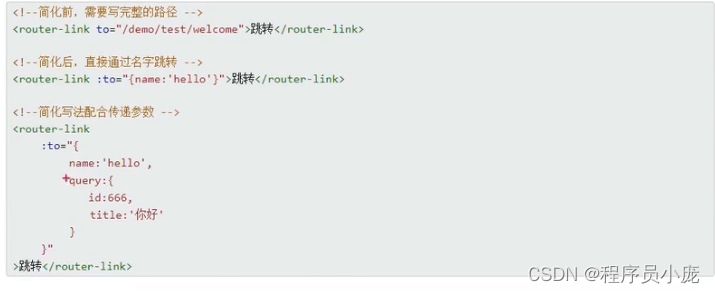
8、路由的params参数
1、配置路由,声明接收 params参数
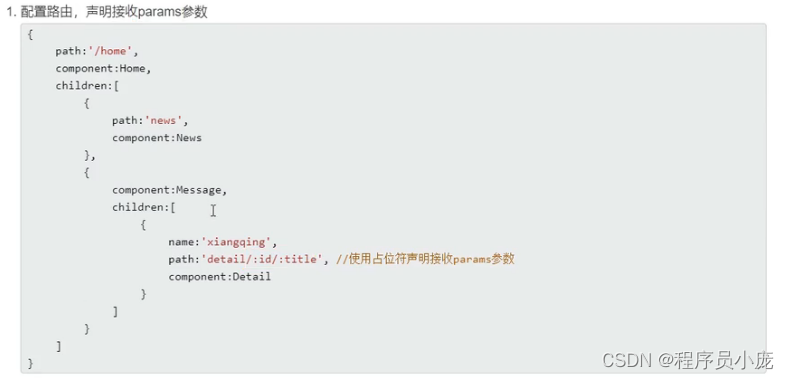
2、传递参数
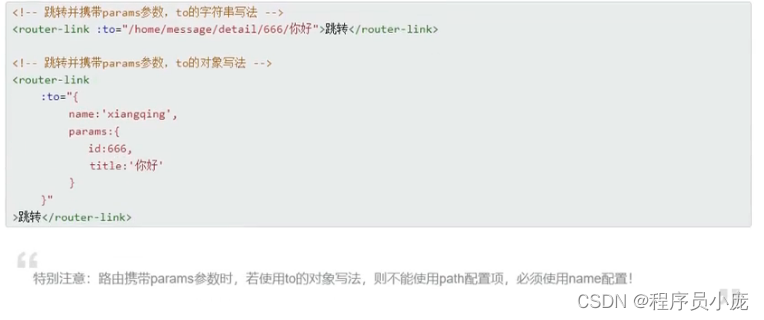
3、接收参数

9.路由的props配置
作用: 让路由组件更方便的收到参数
{
name:'xiangqing',
path:'detail/:id',
component:Detail,
//第一种写法:props值为对象,该对象中所有的key-value的组合最终都会通过props传给Detail组件
// props:{a:900}
//第二种写法:props值为布尔值,布尔值为true,则把路由收到的所有params参数通过props传给Detail组件
// props:true
//第三种写法:props值为函数,该函数返回的对象中每一组key-value都会通过props传给Detail组件
props(route){
return {
id:route.query.id,
title:route.query.title
}
}
}
接收
<template>
<ul>
<li>消息编号:{{id}}</li>
<li>消息标题:{{title}}</li>
</ul>
</template>
<script>
export default {
name:'Detail',
props:['id','title'],
}
</script>
10.<router-link>的replace属性
- 作用:控制路由跳转时操作浏览器历史记录的模式
- 浏览器的历史记录有两种写入方式:分别为
push和replace,push是追加历史记录,replace是替换当前记录。路由跳转时候默认为push - 如何开启
replace模式:<router-link replace .......>News</router-link>
11.编程式路由导航
-
作用:不借助
<router-link>实现路由跳转,让路由跳转更加灵活 -
具体编码:
//$router的两个API this.$router.push({ name:'xiangqing', params:{ id:xxx, title:xxx } }) this.$router.replace({ name:'xiangqing', params:{ id:xxx, title:xxx } }) this.$router.forward() //前进 this.$router.back() //后退 this.$router.go() //可前进也可后退
如:
<template>
<div>
<ul>
<li v-for="m in messageList" :key="m.id">
<!-- 跳转路由并携带params参数,to的字符串写法 -->
<!-- <router-link :to="`/home/message/detail/${m.id}/${m.title}`">{{m.title}}</router-link> -->
<!-- 跳转路由并携带params参数,to的对象写法 -->
<router-link :to="{
name:'xiangqing',
query:{
id:m.id,
title:m.title
}
}">
{{m.title}}
</router-link>
<button @click="pushShow(m)">push查看</button>
<button @click="replaceShow(m)">replace查看</button>
</li>
</ul>
<hr>
<router-view></router-view>
</div>
</template>
<script>
export default {
name:'Message',
data() {
return {
messageList:[
{id:'001',title:'消息001'},
{id:'002',title:'消息002'},
{id:'003',title:'消息003'}
]
}
},
methods: {
pushShow(m){
this.$router.push({
name:'xiangqing',
query:{
id:m.id,
title:m.title
}
})
},
replaceShow(m){
this.$router.replace({
name:'xiangqing',
query:{
id:m.id,
title:m.title
}
})
}
},
}
</script>
<template>
<div class="col-xs-offset-2 col-xs-8">
<div class="page-header">
<h2>Vue Router Demo</h2>
<button @click="back">后退</button>
<button @click="forward">前进</button>
<button @click="test">测试一下go</button>
</div>
</div>
</template>
<script>
export default {
name:'Banner',
methods: {
back(){
this.$router.back()
// console.log(this.$router)
},
forward(){
this.$router.forward()
},
test(){
this.$router.go(3)
}
},
}
</script>
11、缓存路由组件
-
作用:让不展示的路由组件保持挂载,不被销毁。
-
具体编码:
<!-- 缓存多个路由组件 -->
<!-- <keep-alive :include="['News','Message']">
<router-view></router-view>
</keep-alive>
-->
<!-- 缓存一个路由组件 -->
<keep-alive include="不被销毁的组件名">
<router-view></router-view>
</keep-alive>
12.两个新的生命周期钩子
- 作用:路由组件所独有的两个钩子,用于捕获路由组件的激活状态。
- 具体名字:
activated路由组件被激活时触发。deactivated路由组件失活时触发。
<template>
<ul>
<li :style="{opacity}">欢迎学习Vue</li>
<li>news001 <input type="text"></li>
<li>news002 <input type="text"></li>
<li>news003 <input type="text"></li>
</ul>
</template>
<script>
export default {
name:'News',
data() {
return {
opacity:1
}
},
//beforeDestroy和mounted对路由不起作用
/* beforeDestroy() {
console.log('News组件即将被销毁了')
clearInterval(this.timer)
}, */
/* mounted(){
this.timer = setInterval(() => {
console.log('@')
this.opacity -= 0.01
if(this.opacity <= 0) this.opacity = 1
},16)
}, */
activated() {
console.log('News组件被激活了')
this.timer = setInterval(() => {
console.log('@')
this.opacity -= 0.01
if(this.opacity <= 0) this.opacity = 1
},16)
},
deactivated() {
console.log('News组件失活了')
clearInterval(this.timer)
},
}
</script>
13、路由守卫
1. 作用:
对路由进行权限控制
2. 分类:
全局守卫、独享守卫、组件内守卫
3. 全局守卫:
//全局前置守卫:初始化时执行、每次路由切换前执行
router.beforeEach((to,from,next)=>{
console.log('beforeEach',to,from)
if(to.meta.isAuth){ //判断当前路由是否需要进行权限控制
if(localStorage.getItem('school') === 'atguigu'){ //权限控制的具体规则
next() //放行
}else{
alert('暂无权限查看')
// next({name:'guanyu'})
}
}else{
next() //放行
}
})
//全局后置守卫:初始化时执行、每次路由切换后执行
router.afterEach((to,from)=>{
console.log('afterEach',to,from)
if(to.meta.title){
document.title = to.meta.title //修改网页的title
}else{
document.title = 'vue_test'
}
})
如:
// 该文件专门用于创建整个应用的路由器
import VueRouter from 'vue-router'
//引入组件
import About from '../pages/About'
import Home from '../pages/Home'
import News from '../pages/News'
import Message from '../pages/Message'
import Detail from '../pages/Detail'
//创建并暴露一个路由器
const router = new VueRouter({
routes:[
{
name:'guanyu',
path:'/about',
component:About,
meta:{title:'关于'}
},
{
name:'zhuye',
path:'/home',
component:Home,
meta:{title:'主页'},
children:[
{
name:'xinwen',
path:'news',
component:News,
meta:{isAuth:true,title:'新闻'}
},
{
name:'xiaoxi',
path:'message',
component:Message,
meta:{isAuth:true,title:'消息'},
children:[
{
name:'xiangqing',
path:'detail',
component:Detail,
meta:{isAuth:true,title:'详情'},
}
]
}
]
}
]
})
//全局前置路由守卫————初始化的时候被调用、每次路由切换之前被调用
router.beforeEach((to,from,next)=>{
console.log('前置路由守卫',to,from)
if(to.meta.isAuth){ //判断是否需要鉴权
if(localStorage.getItem('school')==='atguigu'){
next()
}else{
alert('学校名不对,无权限查看!')
}
}else{
next()
}
})
//全局后置路由守卫————初始化的时候被调用、每次路由切换之后被调用
router.afterEach((to,from)=>{
console.log('后置路由守卫',to,from)
document.title = to.meta.title || '硅谷系统'
})
export default router
4. 独享守卫:
beforeEnter(to,from,next){
console.log('beforeEnter',to,from)
if(to.meta.isAuth){ //判断当前路由是否需要进行权限控制
if(localStorage.getItem('school') === 'atguigu'){
next()
}else{
alert('暂无权限查看')
// next({name:'guanyu'})
}
}else{
next()
}
}
如:
// 该文件专门用于创建整个应用的路由器
import VueRouter from 'vue-router'
//引入组件
import About from '../pages/About'
import Home from '../pages/Home'
import News from '../pages/News'
import Message from '../pages/Message'
import Detail from '../pages/Detail'
//创建并暴露一个路由器
const router = new VueRouter({
routes:[
{
name:'guanyu',
path:'/about',
component:About,
meta:{title:'关于'}
},
{
name:'zhuye',
path:'/home',
component:Home,
meta:{title:'主页'},
children:[
{
name:'xinwen',
path:'news',
component:News,
meta:{isAuth:true,title:'新闻'},
beforeEnter: (to, from, next) => {
console.log('独享路由守卫',to,from)
if(to.meta.isAuth){ //判断是否需要鉴权
if(localStorage.getItem('school')==='atguigu'){
next()
}else{
alert('学校名不对,无权限查看!')
}
}else{
next()
}
}
},
{
name:'xiaoxi',
path:'message',
component:Message,
meta:{isAuth:true,title:'消息'},
children:[
{
name:'xiangqing',
path:'detail',
component:Detail,
meta:{isAuth:true,title:'详情'},
}
]
}
]
}
]
})
export default router
5. 组件内守卫:
//进入守卫:通过路由规则,进入该组件时被调用
beforeRouteEnter (to, from, next) {
},
//离开守卫:通过路由规则,离开该组件时被调用
beforeRouteLeave (to, from, next) {
}
如:
<template>
<h2>我是About的内容</h2>
</template>
<script>
export default {
name:'About',
//通过路由规则,进入该组件时被调用
beforeRouteEnter (to, from, next) {
console.log('About--beforeRouteEnter',to,from)
if(to.meta.isAuth){ //判断是否需要鉴权
if(localStorage.getItem('school')==='atguigu'){
next()
}else{
alert('学校名不对,无权限查看!')
}
}else{
next()
}
},
//通过路由规则,离开该组件时被调用
beforeRouteLeave (to, from, next) {
console.log('About--beforeRouteLeave',to,from)
next()
}
}
</script>
14、路由器的两种工作模式
- 对于一个url来说,什么是hash值?—— #及其后面的内容就是hash值。
- hash值不会包含在 HTTP 请求中,即:hash值不会带给服务器。
- hash模式:
- 地址中永远带着#号,不美观 。
- 若以后将地址通过第三方手机app分享,若app校验严格,则地址会被标记为不合法。
- 兼容性较好。
- history模式:
- 地址干净,美观 。
- 兼容性和hash模式相比略差。
- 应用部署上线时需要后端人员支持,解决刷新页面服务端404的问题。
如:
// 该文件专门用于创建整个应用的路由器
import VueRouter from 'vue-router'
//引入组件
import About from '../pages/About'
import Home from '../pages/Home'
import News from '../pages/News'
import Message from '../pages/Message'
import Detail from '../pages/Detail'
//创建并暴露一个路由器
const router = new VueRouter({
mode:'history',//选择路由模式
routes:[
]
})
export default router
vue3快速上手
一、创建Vue3.0工程
1.使用 vue-cli 创建
官方文档:https://cli.vuejs.org/zh/guide/creating-a-project.html#vue-create
## 查看@vue/cli版本,确保@vue/cli版本在4.5.0以上
vue --version
## 安装或者升级你的@vue/cli
npm install -g @vue/cli
## 创建
vue create vue_test
## 启动
cd vue_test
npm run serve
2.使用 vite 创建
官方文档:https://v3.cn.vuejs.org/guide/installation.html#vite
vite官网:https://vitejs.cn
- 什么是vite?—— 新一代前端构建工具。
- 优势如下:
- 开发环境中,无需打包操作,可快速的冷启动。
- 轻量快速的热重载(HMR)。
- 真正的按需编译,不再等待整个应用编译完成。
- 传统构建 与 vite构建对比图
## 创建工程
npm init vite-app <project-name>
## 进入工程目录
cd <project-name>
## 安装依赖
npm install
## 运行
npm run dev
3.分析工程结构
main.js
//引入的不再是Vue构造函数了,引入的是一个名为createApp的工厂函数
import { createApp } from 'vue'
import App from './App.vue'
//创建应用实例对象——app(类似于之前Vue2中的vm,但app比vm更“轻”)
const app = createApp(App)
//挂载
app.mount('#app')
二、常用 Composition API
官方文档: https://v3.cn.vuejs.org/guide/composition-api-introduction.html
1.拉开序幕的setup
- 理解:Vue3.0中一个新的配置项,值为一个函数。
- setup是所有Composition API(组合API)“ 表演的舞台 ”。
- 组件中所用到的:数据、方法等等,均要配置在setup中。
- setup函数的两种返回值:
- 若返回一个对象,则对象中的属性、方法, 在模板中均可以直接使用。(重点关注!)
- 若返回一个渲染函数:则可以自定义渲染内容。(了解)
- 注意点:
- 尽量不要与Vue2.x配置混用
- Vue2.x配置(data、methos、computed…)中可以访问到setup中的属性、方法。
- 但在setup中不能访问到Vue2.x配置(data、methos、computed…)。
- 如果有重名, setup优先。
- setup不能是一个async函数,因为返回值不再是return的对象, 而是promise, 模板看不到return对象中的属性。(后期也可以返回一个Promise实例,但需要Suspense和异步组件的配合)
- 尽量不要与Vue2.x配置混用
2.ref函数
- 作用: 定义一个响应式的数据
- 语法:
const xxx = ref(initValue)- 创建一个包含响应式数据的引用对象(reference对象,简称ref对象)。
- JS中操作数据:
xxx.value - 模板中读取数据: 不需要.value,直接:
<div>{{xxx}}</div>
- 备注:
- 接收的数据可以是:基本类型、也可以是对象类型。
- 基本类型的数据:响应式依然是靠
Object.defineProperty()的get与set完成的。 - 对象类型的数据:内部 “ 求助 ” 了Vue3.0中的一个新函数——
reactive函数。
如:
<template>
<h1>一个人的信息</h1>
<h2>姓名:{{name}}</h2>
<h2>年龄:{{age}}</h2>
<h3>工作种类:{{job.type}}</h3>
<h3>工作薪水:{{job.salary}}</h3>
<button @click="changeInfo">修改人的信息</button>
</template>
<script>
import {ref} from 'vue'
export default {
name: 'App',
setup(){
//数据
let name = ref('张三')
let age = ref(18)
let job = ref({
type:'前端工程师',
salary:'30K'
})
//修改方法
function changeInfo(){
name.value = '李四'
age.value = 48
console.log(job.value)
job.value.type = 'UI设计师'
job.value.salary = '60K'
console.log(name,age)
}
//返回一个对象(常用)
return {
name,
age,
job,
changeInfo
}
}
}
</script>
3.reactive函数
- 作用: 定义一个对象类型的响应式数据(基本类型不要用它,要用
ref函数) - 语法:
const 代理对象= reactive(源对象)接收一个对象(或数组),返回一个代理对象(Proxy的实例对象,简称proxy对象) - reactive定义的响应式数据是“深层次的”。
- 内部基于 ES6 的 Proxy 实现,通过代理对象操作源对象内部数据进行操作。
如:
<template>
<h1>一个人的信息</h1>
<h2>姓名:{{person.name}}</h2>
<h2>年龄:{{person.age}}</h2>
<h3>工作种类:{{person.job.type}}</h3>
<h3>工作薪水:{{person.job.salary}}</h3>
<h3>爱好:{{person.hobby}}</h3>
<h3>测试的数据c:{{person.job.a.b.c}}</h3>
<button @click="changeInfo">修改人的信息</button>
</template>
<script>
import {reactive} from 'vue'
export default {
name: 'App',
setup(){
//数据
let person = reactive({
name:'张三',
age:18,
job:{
type:'前端工程师',
salary:'30K',
a:{
b:{
c:666
}
}
},
hobby:['抽烟','喝酒','烫头']
})
//方法
function changeInfo(){
person.name = '李四'
person.age = 48
person.job.type = 'UI设计师'
person.job.salary = '60K'
person.job.a.b.c = 999
person.hobby[0] = '学习'
}
//返回一个对象(常用)
return {
person,
changeInfo
}
}
}
</script>
4.Vue3.0中的响应式原理
vue2.x的响应式
-
实现原理:
-
对象类型:通过
Object.defineProperty()对属性的读取、修改进行拦截(数据劫持)。 -
数组类型:通过重写更新数组的一系列方法来实现拦截。(对数组的变更方法进行了包裹)。
Object.defineProperty(data, 'count', { get () {}, set () {} })
-
-
存在问题:
- 新增属性、删除属性, 界面不会更新。
- 直接通过下标修改数组, 界面不会自动更新。
Vue3.0的响应式
-
实现原理:
-
通过Proxy(代理): 拦截对象中任意属性的变化, 包括:属性值的读写、属性的添加、属性的删除等。
-
通过Reflect(反射): 对源对象的属性进行操作。
-
MDN文档中描述的Proxy与Reflect:
-
Proxy:https://developer.mozilla.org/zh-CN/docs/Web/JavaScript/Reference/Global_Objects/Proxy
-
Reflect:https://developer.mozilla.org/zh-CN/docs/Web/JavaScript/Reference/Global_Objects/Reflect
new Proxy(data, { // 拦截读取属性值 get (target, prop) { return Reflect.get(target, prop) }, // 拦截设置属性值或添加新属性 set (target, prop, value) { return Reflect.set(target, prop, value) }, // 拦截删除属性 deleteProperty (target, prop) { return Reflect.deleteProperty(target, prop) } }) proxy.name = 'tom'
-
-
5.reactive对比ref
- 从定义数据角度对比:
- ref用来定义:基本类型数据。
- reactive用来定义:对象(或数组)类型数据。
- 备注:ref也可以用来定义对象(或数组)类型数据, 它内部会自动通过
reactive转为代理对象。
- 从原理角度对比:
- ref通过
Object.defineProperty()的get与set来实现响应式(数据劫持)。 - reactive通过使用Proxy来实现响应式(数据劫持), 并通过Reflect操作源对象内部的数据。
- ref通过
- 从使用角度对比:
- ref定义的数据:操作数据需要
.value,读取数据时模板中直接读取不需要.value。 - reactive定义的数据:操作数据与读取数据:均不需要
.value。
- ref定义的数据:操作数据需要
6.setup的两个注意点
-
setup执行的时机
- 在beforeCreate之前执行一次,this是undefined。
-
setup的参数
- props:值为对象,包含:组件外部传递过来,且组件内部声明接收了的属性。
- context:上下文对象
- attrs: 值为对象,包含:组件外部传递过来,但没有在props配置中声明的属性, 相当于
this.$attrs。 - slots: 收到的插槽内容, 相当于
this.$slots。 - emit: 分发自定义事件的函数, 相当于
this.$emit。
- attrs: 值为对象,包含:组件外部传递过来,但没有在props配置中声明的属性, 相当于
7.计算属性与监视
1.computed函数
-
与Vue2.x中computed配置功能一致
-
写法
import {computed} from 'vue' setup(){ //数据 let person = reactive({ firstName:'张', lastName:'三' }) //计算属性——简写(没有考虑计算属性被修改的情况) /* person.fullName = computed(()=>{ return person.firstName + '-' + person.lastName }) */ //计算属性——简写 let fullName = computed(()=>{ return person.firstName + '-' + person.lastName }) //计算属性——完整 let fullName = computed({ get(){ return person.firstName + '-' + person.lastName }, set(value){ const nameArr = value.split('-') person.firstName = nameArr[0] person.lastName = nameArr[1] } }) }
如:
<template>
<h1>一个人的信息</h1>
姓:<input type="text" v-model="person.firstName">
<br>
名:<input type="text" v-model="person.lastName">
<br>
<span>全名:{{person.fullName}}</span>
<br>
全名:<input type="text" v-model="person.fullName">
</template>
<script>
import {reactive,computed} from 'vue'
export default {
name: 'Demo',
setup(){
//数据
let person = reactive({
firstName:'张',
lastName:'三'
})
//计算属性——简写(没有考虑计算属性被修改的情况)
/* person.fullName = computed(()=>{
return person.firstName + '-' + person.lastName
}) */
//计算属性——完整写法(考虑读和写)
person.fullName = computed({
get(){
return person.firstName + '-' + person.lastName
},
set(value){
const nameArr = value.split('-')
person.firstName = nameArr[0]
person.lastName = nameArr[1]
}
})
//返回一个对象(常用)
return {
person
}
}
}
</script>
2.watch函数
-
与Vue2.x中watch配置功能一致
-
两个小“坑”:
- 监视reactive定义的响应式数据时:oldValue无法正确获取、强制开启了深度监视(deep配置失效)。
- 监视reactive定义的响应式数据中某个属性时:deep配置有效。
//情况一:监视ref定义的响应式数据 watch(sum,(newValue,oldValue)=>{ console.log('sum变化了',newValue,oldValue) },{immediate:true}) //情况二:监视多个ref定义的响应式数据 watch([sum,msg],(newValue,oldValue)=>{ console.log('sum或msg变化了',newValue,oldValue) }) /* 情况三:监视reactive定义的响应式数据 若watch监视的是reactive定义的响应式数据,则无法正确获得oldValue!! 若watch监视的是reactive定义的响应式数据,则强制开启了深度监视 */ watch(person,(newValue,oldValue)=>{ console.log('person变化了',newValue,oldValue) },{immediate:true,deep:false}) //此处的deep配置不再奏效 //情况四:监视reactive定义的响应式数据中的某个属性 watch(()=>person.job,(newValue,oldValue)=>{ console.log('person的job变化了',newValue,oldValue) },{immediate:true,deep:true}) //情况五:监视reactive定义的响应式数据中的某些属性 watch([()=>person.job,()=>person.name],(newValue,oldValue)=>{ console.log('person的job变化了',newValue,oldValue) },{immediate:true,deep:true}) //特殊情况 watch(()=>person.job,(newValue,oldValue)=>{ console.log('person的job变化了',newValue,oldValue) },{deep:true}) //此处由于监视的是reactive素定义的对象中的某个属性,所以deep配置有效
如:
<template>
<h2>当前求和为:{{sum}}</h2>
<button @click="sum++">点我+1</button>
<hr>
<h2>当前的信息为:{{msg}}</h2>
<button @click="msg+='!'">修改信息</button>
<hr>
<h2>姓名:{{person.name}}</h2>
<h2>年龄:{{person.age}}</h2>
<h2>薪资:{{person.job.j1.salary}}K</h2>
<button @click="person.name+='~'">修改姓名</button>
<button @click="person.age++">增长年龄</button>
<button @click="person.job.j1.salary++">涨薪</button>
</template>
<script>
import {ref,reactive,watch} from 'vue'
export default {
name: 'Demo',
setup(){
//数据
let sum = ref(0)
let msg = ref('你好啊')
let person = reactive({
name:'张三',
age:18,
job:{
j1:{
salary:20
}
}
})
//情况一:监视ref所定义的一个响应式数据
/* watch(sum,(newValue,oldValue)=>{
console.log('sum变了',newValue,oldValue)
},{immediate:true}) */
//情况二:监视ref所定义的多个响应式数据
/* watch([sum,msg],(newValue,oldValue)=>{
console.log('sum或msg变了',newValue,oldValue)
},{immediate:true}) */
/*
情况三:监视reactive所定义的一个响应式数据的全部属性
1.注意:此处无法正确的获取oldValue
2.注意:强制开启了深度监视(deep配置无效)
*/
/* watch(person,(newValue,oldValue)=>{
console.log('person变化了',newValue,oldValue)
},{deep:false}) //此处的deep配置无效 */
//情况四:监视reactive所定义的一个响应式数据中的某个属性
/* watch(()=>person.name,(newValue,oldValue)=>{
console.log('person的name变化了',newValue,oldValue)
}) */
//情况五:监视reactive所定义的一个响应式数据中的某些属性
/* watch([()=>person.name,()=>person.age],(newValue,oldValue)=>{
console.log('person的name或age变化了',newValue,oldValue)
}) */
//特殊情况
/* watch(()=>person.job,(newValue,oldValue)=>{
console.log('person的job变化了',newValue,oldValue)
},{deep:true}) //此处由于监视的是reactive素定义的对象中的某个属性,所以deep配置有效 */
//返回一个对象(常用)
return {
sum,
msg,
person
}
}
}
</script>
3.watchEffect函数
-
watch的套路是:既要指明监视的属性,也要指明监视的回调。
-
watchEffect的套路是:不用指明监视哪个属性,监视的回调中用到哪个属性,那就监视哪个属性。
-
watchEffect有点像computed:
- 但computed注重的计算出来的值(回调函数的返回值),所以必须要写返回值。
- 而watchEffect更注重的是过程(回调函数的函数体),所以不用写返回值。
//watchEffect所指定的回调中用到的数据只要发生变化,则直接重新执行回调。 watchEffect(()=>{ const x1 = sum.value const x2 = person.age console.log('watchEffect配置的回调执行了') })
如:
<template>
<h2>当前求和为:{{sum}}</h2>
<button @click="sum++">点我+1</button>
<hr>
<h2>当前的信息为:{{msg}}</h2>
<button @click="msg+='!'">修改信息</button>
<hr>
<h2>姓名:{{person.name}}</h2>
<h2>年龄:{{person.age}}</h2>
<h2>薪资:{{person.job.j1.salary}}K</h2>
<button @click="person.name+='~'">修改姓名</button>
<button @click="person.age++">增长年龄</button>
<button @click="person.job.j1.salary++">涨薪</button>
</template>
<script>
import {ref,reactive,watch,watchEffect} from 'vue'
export default {
name: 'Demo',
setup(){
//数据
let sum = ref(0)
let msg = ref('你好啊')
let person = reactive({
name:'张三',
age:18,
job:{
j1:{
salary:20
}
}
})
//监视
/* watch(sum,(newValue,oldValue)=>{
console.log('sum的值变化了',newValue,oldValue)
},{immediate:true}) */
watchEffect(()=>{
const x1 = sum.value
const x2 = person.job.j1.salary
console.log('watchEffect所指定的回调执行了')
})
//返回一个对象(常用)
return {
sum,
msg,
person
}
}
}
</script>
8.生命周期
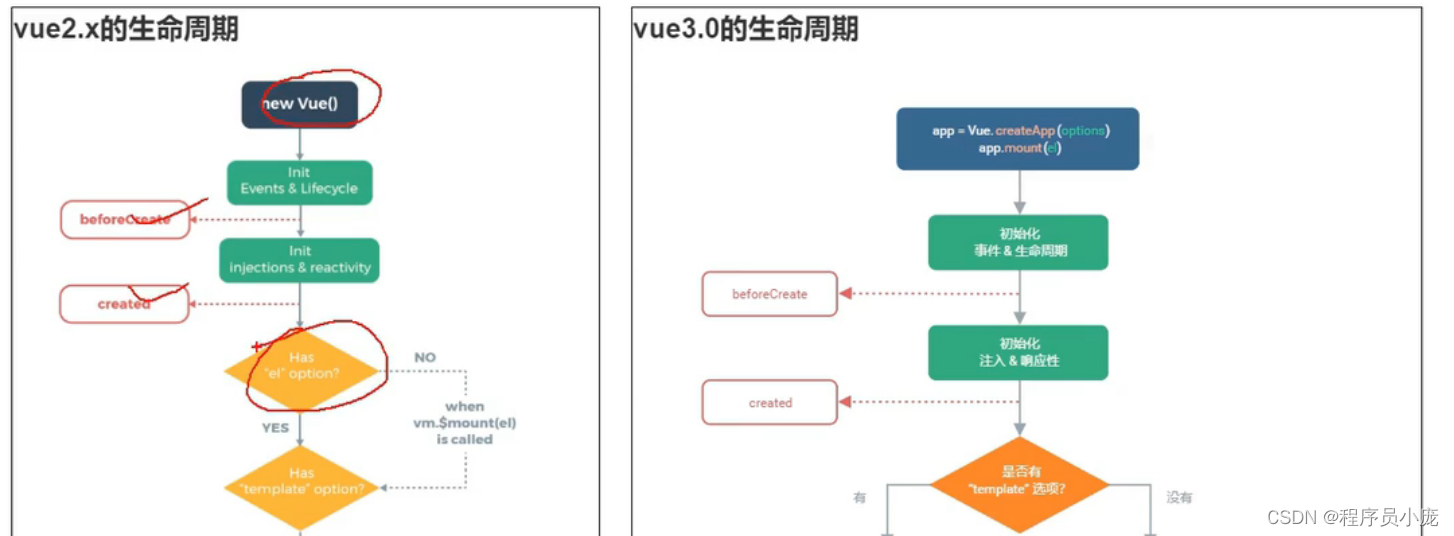

- Vue3.0中可以继续使用Vue2.x中的生命周期钩子,但有有两个被更名:
beforeDestroy改名为beforeUnmountdestroyed改名为unmounted
- Vue3.0也提供了 Composition API 形式的生命周期钩子,与Vue2.x中钩子对应关系如下:
beforeCreate===>setup()created=======>setup()beforeMount===>onBeforeMountmounted=======>onMountedbeforeUpdate===>onBeforeUpdateupdated=======>onUpdatedbeforeUnmount==>onBeforeUnmountunmounted=====>onUnmounted
注意:组合式API比配置项优先级高
如:
<template>
<h2>当前求和为:{{sum}}</h2>
<button @click="sum++">点我+1</button>
</template>
<script>
import {ref,onBeforeMount,onMounted,onBeforeUpdate,onUpdated,onBeforeUnmount,onUnmounted} from 'vue'
export default {
name: 'Demo',
setup(){
console.log('---setup---')
//数据
let sum = ref(0)
//通过组合式API的形式去使用生命周期钩子
onBeforeMount(()=>{
console.log('---onBeforeMount---')
})
onMounted(()=>{
console.log('---onMounted---')
})
onBeforeUpdate(()=>{
console.log('---onBeforeUpdate---')
})
onUpdated(()=>{
console.log('---onUpdated---')
})
onBeforeUnmount(()=>{
console.log('---onBeforeUnmount---')
})
onUnmounted(()=>{
console.log('---onUnmounted---')
})
//返回一个对象(常用)
return {sum}
},
//通过配置项的形式使用生命周期钩子
//#region
beforeCreate() {
console.log('---beforeCreate---')
},
created() {
console.log('---created---')
},
beforeMount() {
console.log('---beforeMount---')
},
mounted() {
console.log('---mounted---')
},
beforeUpdate(){
console.log('---beforeUpdate---')
},
updated() {
console.log('---updated---')
},
beforeUnmount() {
console.log('---beforeUnmount---')
},
unmounted() {
console.log('---unmounted---')
},
//#endregion
}
</script>
9.自定义hook函数
-
什么是hook?—— 本质是一个函数,把setup函数中使用的Composition API进行了封装。
-
类似于vue2.x中的mixin。
-
自定义hook的优势: 复用代码, 让setup中的逻辑更清楚易懂。
如:
1、创建usePoint.js
import {reactive,onMounted,onBeforeUnmount} from 'vue'
export default function (){
//实现鼠标“打点”相关的数据
let point = reactive({
x:0,
y:0
})
//实现鼠标“打点”相关的方法
function savePoint(event){
point.x = event.pageX
point.y = event.pageY
console.log(event.pageX,event.pageY)
}
//实现鼠标“打点”相关的生命周期钩子
onMounted(()=>{
window.addEventListener('click',savePoint)
})
onBeforeUnmount(()=>{
window.removeEventListener('click',savePoint)
})
return point
}
2、在需要的地方引入调用即可
<template>
<h2>我是Test组件</h2>
<h2>当前点击时鼠标的坐标为:x:{{point.x}},y:{{point.y}}</h2>
</template>
<script>
import usePoint from '../hooks/usePoint'
export default {
name:'Test',
setup(){
const point = usePoint()
return {point}
}
}
</script>
10.toRef
-
作用:创建一个 ref 对象,其value值指向另一个对象中的某个属性。
-
语法:
const name = toRef(person,'name') -
应用: 要将响应式对象中的某个属性单独提供给外部使用时。
-
扩展:
toRefs与toRef功能一致,但可以批量创建多个 ref 对象,语法:toRefs(person)
如:
<template>
<h4>{{person}}</h4>
<h2>姓名:{{name}}</h2>
<h2>年龄:{{age}}</h2>
<h2>薪资:{{job.j1.salary}}K</h2>
<button @click="name+='~'">修改姓名</button>
<button @click="age++">增长年龄</button>
<button @click="job.j1.salary++">涨薪</button>
</template>
<script>
import {ref,reactive,toRef,toRefs} from 'vue'
export default {
name: 'Demo',
setup(){
//数据
let person = reactive({
name:'张三',
age:18,
job:{
j1:{
salary:20
}
}
})
// const name1 = person.name
// console.log('%%%',name1)
// const name2 = toRef(person,'name')
// console.log('####',name2)
const x = toRefs(person)
console.log('******',x)
//返回一个对象(常用)
return {
person,
// name:toRef(person,'name'),
// age:toRef(person,'age'),
// salary:toRef(person.job.j1,'salary'),
...toRefs(person)
}
}
}
</script>
三、其它 Composition API
1.shallowReactive 与 shallowRef
-
shallowReactive:只处理对象最外层属性的响应式(浅响应式)。
-
shallowRef:只处理基本数据类型的响应式, 不进行对象的响应式处理。
-
什么时候使用?
- 如果有一个对象数据,结构比较深, 但变化时只是外层属性变化 ===> shallowReactive。
- 如果有一个对象数据,后续功能不会修改该对象中的属性,而是生新的对象来替换 ===> shallowRef。
如:
<template>
<h4>当前的x.y值是:{{x.y}}</h4>
<button @click="x={y:888}">点我替换x</button>
<button @click="x.y++">点我x.y++</button>
<hr>
<h4>{{person}}</h4>
<h2>姓名:{{name}}</h2>
<h2>年龄:{{age}}</h2>
<h2>薪资:{{job.j1.salary}}K</h2>
<button @click="name+='~'">修改姓名</button>
<button @click="age++">增长年龄</button>
<button @click="job.j1.salary++">涨薪</button>
</template>
<script>
import {ref,reactive,toRef,toRefs,shallowReactive,shallowRef} from 'vue'
export default {
name: 'Demo',
setup(){
//数据
// let person = shallowReactive({ //只考虑第一层数据的响应式
let person = reactive({
name:'张三',
age:18,
job:{
j1:{
salary:20
}
}
})
let x = shallowRef({
y:0
})
console.log('******',x)
//返回一个对象(常用)
return {
x,
person,
...toRefs(person)
}
}
}
</script>
2.readonly 与 shallowReadonly
- readonly: 让一个响应式数据变为只读的(深只读)。
- shallowReadonly:让一个响应式数据变为只读的(浅只读)。
- 应用场景: 不希望数据被修改时。
如:
<template>
<h4>当前求和为:{{sum}}</h4>
<button @click="sum++">点我++</button>
<hr>
<h2>姓名:{{name}}</h2>
<h2>年龄:{{age}}</h2>
<h2>薪资:{{job.j1.salary}}K</h2>
<button @click="name+='~'">修改姓名</button>
<button @click="age++">增长年龄</button>
<button @click="job.j1.salary++">涨薪</button>
</template>
<script>
import {ref,reactive,toRefs,readonly,shallowReadonly} from 'vue'
export default {
name: 'Demo',
setup(){
//数据
let sum = ref(0)
let person = reactive({
name:'张三',
age:18,
job:{
j1:{
salary:20
}
}
})
person = readonly(person)
// person = shallowReadonly(person)
// sum = readonly(sum)
// sum = shallowReadonly(sum)
//返回一个对象(常用)
return {
sum,
...toRefs(person)
}
}
}
</script>
3.toRaw 与 markRaw
- toRaw:
- 作用:将一个由
reactive生成的响应式对象转为普通对象。 - 使用场景:用于读取响应式对象对应的普通对象,对这个普通对象的所有操作,不会引起页面更新。
- 作用:将一个由
- markRaw:
- 作用:标记一个对象,使其永远不会再成为响应式对象。
- 应用场景:
- 有些值不应被设置为响应式的,例如复杂的第三方类库等。
- 当渲染具有不可变数据源的大列表时,跳过响应式转换可以提高性能。
<template>
<h4>当前求和为:{{sum}}</h4>
<button @click="sum++">点我++</button>
<hr>
<h2>姓名:{{name}}</h2>
<h2>年龄:{{age}}</h2>
<h2>薪资:{{job.j1.salary}}K</h2>
<h3 v-show="person.car">座驾信息:{{person.car}}</h3>
<button @click="name+='~'">修改姓名</button>
<button @click="age++">增长年龄</button>
<button @click="job.j1.salary++">涨薪</button>
<button @click="showRawPerson">输出最原始的person</button>
<button @click="addCar">给人添加一台车</button>
<button @click="person.car.name+='!'">换车名</button>
<button @click="changePrice">换价格</button>
</template>
<script>
import {ref,reactive,toRefs,toRaw,markRaw} from 'vue'
export default {
name: 'Demo',
setup(){
//数据
let sum = ref(0)
let person = reactive({
name:'张三',
age:18,
job:{
j1:{
salary:20
}
}
})
function showRawPerson(){
const p = toRaw(person)
p.age++
console.log(p)
}
function addCar(){
let car = {name:'奔驰',price:40}
person.car = markRaw(car)
}
function changePrice(){
person.car.price++
console.log(person.car.price)
}
//返回一个对象(常用)
return {
sum,
person,
...toRefs(person),
showRawPerson,
addCar,
changePrice
}
}
}
</script>
4.customRef
-
作用:创建一个自定义的 ref,并对其依赖项跟踪和更新触发进行显式控制。
-
实现防抖效果:
<template>
<input type="text" v-model="keyword">
<h3>{{keyword}}</h3>
</template>
<script>
import {ref,customRef} from 'vue'
export default {
name:'Demo',
setup(){
// let keyword = ref('hello') //使用Vue准备好的内置ref
//自定义一个myRef
function myRef(value,delay){
let timer
//通过customRef去实现自定义
return customRef((track,trigger)=>{
return{
get(){
track() //告诉Vue这个value值是需要被“追踪”的
return value
},
set(newValue){
clearTimeout(timer)
timer = setTimeout(()=>{
value = newValue
trigger() //告诉Vue去更新界面
},delay)
}
}
})
}
let keyword = myRef('hello',500) //使用程序员自定义的ref
return {
keyword
}
}
}
</script>
5.provide 与 inject
-
作用:实现祖与后代组件间通信
-
套路:父组件有一个
provide选项来提供数据,后代组件有一个inject选项来开始使用这些数据 -
具体写法:
-
祖组件中:
setup(){ ...... let car = reactive({name:'奔驰',price:'40万'}) provide('car',car) ...... } -
后代组件中:
setup(props,context){ ...... const car = inject('car') return {car} ...... }
-
如:
App.vue
<template>
<div class="app">
<h3>我是App组件(祖),{{name}}--{{price}}</h3>
<Child/>
</div>
</template>
<script>
import { reactive,toRefs,provide } from 'vue'
import Child from './components/Child.vue'
export default {
name:'App',
components:{Child},
setup(){
let car = reactive({name:'奔驰',price:'40W'})
provide('car',car) //给自己的后代组件传递数据
return {...toRefs(car)}
}
}
</script>
<style>
.app{
background-color: gray;
padding: 10px;
}
</style>
Child.vue组件
<template>
<div class="child">
<h3>我是Child组件(子)</h3>
<Son/>
</div>
</template>
<script>
import {inject} from 'vue'
import Son from './Son.vue'
export default {
name:'Child',
components:{Son},
/* setup(){
let x = inject('car')
console.log(x,'Child-----')
} */
}
</script>
<style>
.child{
background-color: skyblue;
padding: 10px;
}
</style>
Son组件(孙)
<template>
<div class="son">
<h3>我是Son组件(孙),{{car.name}}--{{car.price}}</h3>
</div>
</template>
<script>
import {inject} from 'vue'
export default {
name:'Son',
setup(){
let car = inject('car')
return {car}
}
}
</script>
<style>
.son{
background-color: orange;
padding: 10px;
}
</style>
6.响应式数据的判断
- isRef: 检查一个值是否为一个 ref 对象
- isReactive: 检查一个对象是否是由
reactive创建的响应式代理 - isReadonly: 检查一个对象是否是由
readonly创建的只读代理 - isProxy: 检查一个对象是否是由
reactive或者readonly方法创建的代理
<template>
<h3>我是App组件</h3>
</template>
<script>
import {ref, reactive,toRefs,readonly,isRef,isReactive,isReadonly,isProxy } from 'vue'
export default {
name:'App',
setup(){
let car = reactive({name:'奔驰',price:'40W'})
let sum = ref(0)
let car2 = readonly(car)
console.log(isRef(sum))
console.log(isReactive(car))
console.log(isReadonly(car2))
console.log(isProxy(car))
console.log(isProxy(sum))
return {...toRefs(car)}
}
}
</script>
<style>
.app{
background-color: gray;
padding: 10px;
}
</style>
四、Composition API 的优势
1.Options API 存在的问题
使用传统OptionsAPI中,新增或者修改一个需求,就需要分别在data,methods,computed里修改 。
.Composition API 的优势
我们可以更加优雅的组织我们的代码,函数。让相关功能的代码更加有序的组织在一起。(但要利用hook函数)
五、新的组件
1.Fragment
- 在Vue2中: 组件必须有一个根标签
- 在Vue3中: 组件可以没有根标签, 内部会将多个标签包含在一个Fragment虚拟元素中
- 好处: 减少标签层级, 减小内存占用
2.Teleport
-
什么是Teleport?——
Teleport是一种能够将我们的组件html结构移动到指定位置的技术。<teleport to="移动位置"> <div v-if="isShow" class="mask"> <div class="dialog"> <h3>我是一个弹窗</h3> <button @click="isShow = false">关闭弹窗</button> </div> </div> </teleport>
如:
<template>
<div>
<button @click="isShow = true">点我弹个窗</button>
<teleport to="body">
<div v-if="isShow" class="mask">
<div class="dialog">
<h3>我是一个弹窗</h3>
<h4>一些内容</h4>
<h4>一些内容</h4>
<h4>一些内容</h4>
<button @click="isShow = false">关闭弹窗</button>
</div>
</div>
</teleport>
</div>
</template>
<script>
import {ref} from 'vue'
export default {
name:'Dialog',
setup(){
let isShow = ref(false)
return {isShow}
}
}
</script>
<style>
.mask{
position: absolute;
top: 0;bottom: 0;left: 0;right: 0;
background-color: rgba(0, 0, 0, 0.5);
}
.dialog{
position: absolute;
top: 50%;
left: 50%;
transform: translate(-50%,-50%);
text-align: center;
width: 300px;
height: 300px;
background-color: green;
}
</style>
3.Suspense
-
等待异步组件时渲染一些额外内容,让应用有更好的用户体验
-
使用步骤:
-
异步引入组件
import {defineAsyncComponent} from 'vue' const Child = defineAsyncComponent(()=>import('./components/Child.vue')) -
使用
Suspense包裹组件,并配置好default与fallback<template> <div class="app"> <h3>我是App组件</h3> <Suspense> <template v-slot:default> <Child/> </template> <template v-slot:fallback> <h3>加载中.....</h3> </template> </Suspense> </div> </template>
-
如:
App.vue
<template>
<div class="app">
<h3>我是App组件</h3>
<Suspense>
<template v-slot:default>
<Child/>
</template>
<template v-slot:fallback>
<h3>稍等,加载中...</h3>
</template>
</Suspense>
</div>
</template>
<script>
// import Child from './components/Child'//静态引入
import {defineAsyncComponent} from 'vue' //定义一个异步组件
const Child = defineAsyncComponent(()=>import('./components/Child')) //异步引入
export default {
name:'App',
components:{Child},
}
</script>
<style>
.app{
background-color: gray;
padding: 10px;
}
</style>
clild.vue
<template>
<div class="child">
<h3>我是Child组件</h3>
{{sum}}
</div>
</template>
<script>
import {ref} from 'vue'
export default {
name:'Child',
async setup(){
let sum = ref(0)
let p = new Promise((resolve,reject)=>{
setTimeout(()=>{
resolve({sum})
},3000)
})
return await p
}
}
</script>
<style>
.child{
background-color: skyblue;
padding: 10px;
}
</style>
六、其他
1.全局API的转移
-
Vue 2.x 有许多全局 API 和配置。
-
例如:注册全局组件、注册全局指令等。
//注册全局组件 Vue.component('MyButton', { data: () => ({ count: 0 }), template: '<button @click="count++">Clicked {{ count }} times.</button>' }) //注册全局指令 Vue.directive('focus', { inserted: el => el.focus() }
-
-
Vue3.0中对这些API做出了调整:
-
将全局的API,即:
Vue.xxx调整到应用实例(app)上2.x 全局 API( Vue)3.x 实例 API ( app)Vue.config.xxxx app.config.xxxx Vue.config.productionTip 移除 Vue.component app.component Vue.directive app.directive Vue.mixin app.mixin Vue.use app.use Vue.prototype app.config.globalProperties
-
2.其他改变
-
data选项应始终被声明为一个函数。
-
过度类名的更改:
-
Vue2.x写法
.v-enter, .v-leave-to { opacity: 0; } .v-leave, .v-enter-to { opacity: 1; } -
Vue3.x写法
.v-enter-from, .v-leave-to { opacity: 0; } .v-leave-from, .v-enter-to { opacity: 1; }
-
-
移除keyCode作为 v-on 的修饰符,同时也不再支持
config.keyCodes -
移除
v-on.native修饰符-
父组件中绑定事件
<my-component v-on:close="handleComponentEvent" v-on:click="handleNativeClickEvent" /> -
子组件中声明自定义事件
<script> export default { emits: ['close'] } </script>
-
-
移除过滤器(filter)
过滤器虽然这看起来很方便,但它需要一个自定义语法,打破大括号内表达式是 “只是 JavaScript” 的假设,这不仅有学习成本,而且有实现成本!建议用方法调用或计算属性去替换过滤器。
-
…
第三方库
提供第三方库的网站:https://www.bootcdn.cn/
好用的第三方库:
dayjs是一个轻量的处理时间和日期的 JavaScript 库,和 Moment.js 的 API 设计保持完全一样
浏览器本地存储
webStorage: SessionStorage和LocalStorage都称为webStorage
1.存储内容大小一般支持5MB左右 (不同浏览器可能还不一样)
2.浏览器端通过 Window.sessionStorage 和 Window.localStorage 属性来实现本地存储机制。
3.相关API:
1. xxxxxStorage.setItem(' key", 'value');
该方法接受一个键和值作为参数,会把键值对添加到存储中,如果键名存在,则更新其对应的值。
2. xxxxxStorage.getItem('person');
该方法接受一个键名作为参数,返回键名对应的值。
3.xxxxxStorage.removeItem( " key");
该方法接受一个键名作为参数,并把该键名从存储中删除。
4.xxxxxStorage.clear()
该方法会清空存储中的所有数据
备注:
1.SessionStorage存储的内容会随着浏览器窗口关闭而消失
2.LocalStorage存储的内容,需要手动清除才会消失。
3.xxxxxStorage.getItem(xxx) 如果xxx对应的value获取不到,那么getltem的返回值是null。
4.JsoN.parse(nu11)的结果依然是null。

